
- Forum Listing
- Advanced Search
- Training Horses
- Training, Behavioral, Performance Queries

My horse doesn't want to trail ride alone
- Add to quote
I have a horse who is does not want to go on trail rides without the company of another horse. What can I do make him understand that it isn't so bad going alone?
I think if you're able to do it safely, and have a cell phone etc. it sounds like you need to do it a lot more. Just because you're trail riding doesn't mean your horse doesn't have to listen or work hard; take them by themselves often and if they aren't listening to you, make them work harder.
Wet saddle blankets as well as being the leader in all aspects of handling the horse. Which means he gets by with nothing on the ground either, as that will come out under saddle. As for understanding it isn't so bad? Horses do not think like that, so you need to disregard that mindset. Horses have a good idea of what they want to do, and many times it does not gee haw with wishes of rider. A confident rider and handler, goes a long way to getting horse moving. And what exactly is your horse doing? Balking, spinning, rearing, backing?
Approach it as any other training session. When teaching a horse to side pass, people don't go out with the idea of being able to open a bunch of gates the first day. First you must get that one step good. It's the same with getting a horse used to trail riding. You need to teach your horse to be a trail horse before trail riding. Show your horse that going down the trail is the better option. Ask him to walk off the direction you want down the trail. If he chooses to stop or turn around that's fine, let him make that choice. Then make that choice hard, trot some circles for a few moments then point him back to the trail and slow him to a walk. Anytime he is pointing toward the trail, make it easy for him. Rub him in the wither and don't put much pressure on him. If he gets worried about something don't push him through it. Flex his head and get him to relax. Once she's relaxed ask him to walk on. Don't worry about going far, since it's not about that at this point. You want to regularly back track and work harder at your starting point then letting him walk down the trail. By doing it this way you're creating a horse that is never going develop the habit of rushing home or turning back for home. Another reason is if he does break to a trot when you turn back home. The closer a horse is to what they're going toward the less inclined they'll be to try and get there very quickly. In this case, slow him to a walk, then trot when he gets where he wants to be. If he pulls against you, trot circles right there then point him back to the trail and stand. As he gets better at a short distance, then you can increase it to where you're actually able to go trail ride.
The background to why he won't go alone is because the woods and field we ride in are also near a fish pond where people go fishing and some people there hate having the horses go by. He is not actually my horse, I am working with a woman and riding her horses. Before I started working with this horse, another rider, who worked there took him out by the pond to get to the woods. They encountered some people who where fishing there and they backed him and the rider into a corner waving their rods in their hands at them because they didn't want them riding on that path. They think that the horses disrupt the fish in the pond, which doesn't even make sense. What I mean by for him to "understand that it isn't bad" is actually that he won't always get scared by the people fishing there. He doesn't want to go near the pond by himself anymore because he associates that place with where he got "attacked" (for a lack of a better term) Sorry that my threads are confusing. I am trying to get the hang of asking questions and how much detail I need to add and how to word things. I know that horses think differently than humans, but they do still feel things and definitely remember traumatizing experiences. Every time you try to bring him closer to the pond, he stops moving and no matter what you do he will not move forward. I have tried circling him, bringing him to different areas first, walking closer and closer everyday to the pond, but it is a slow work in progress. I was hoping someone might be able to come up with a better idea.
He doesn't think he was attacked. He remembers something unpleasant happened there but horses don't dwell on things the way people do. Horses live I'm the moment. That's why horses can often overcome fears they have had their entire life within a couple training sessions whereas people often need intensive therapy. I think you'll have much more success with this horse if you don't think about what happened there in the first place. Go back and retread my post as well. It's not about circling and trying to get him to go anywhere. It's about teaching him to choose to WANT to go where you want.
IMHO, if he does fine with other riders/horses, then it's not the place that is the problem, but rather who he trusts while there. IOW, he trusts other horses and himself over you. He's not confident and you can't give him what you don't know. BTW, he's not alone - he's with you.
I was in a similar situation. My horse Harley while riding down a road got bit pretty badly in the leg by a dog. After that he was terrified to go near that road. He wouldn't go near it alone, with other horses, or even being led. We'd try and turn onto that road and he'd be spinning around and running for home. Normally without me in toe. I spent about a good month of every day riding him to the road. We would trot and canter right pass the turn for that road until he was a bit tired, then I'd stop and turn him to face the road. He'd get to rest for a few minutes then we'd trot again. For the first day or two he got to rest only when he'd stop and look at the scary road. He quickly became okay with having to look at the road and stand in front of it Then I started to ask him to take a step closer to the road before his got his break. First few times he'd refuse and we'd be back to trotting. Finally he took that step and go to rest. Pretty soon he was happy to take that step towards the road to get his break Then I wanted two steps before he got his break. Then three. And so on. Now he is more then happy to walk down the road. Though he will still tense a tiny bit when we walk right past the spot he got bit. But he won't refuse. Harley had another incident where a tree branch fell and landed about five feet in front of him. He'd flat out refuse to move past that spot after that. There wasn't enough room to do my usual trot until tired game. A friend who does a lot of training hopped up on him for me. She said as long as he moved his feet he'd forget about his little fear. She'd start him about 20 ft from the spot and make him back up until he passed it. For some reason he'd do it in reverse. She spent a while making him back up over it and then go forward over the spot. Now he is great about it.
it is not a sin to get off and lead your horse over to the pond. I bet he will feel better about that. sometimes, if they have even just one good experience, that whole "mental roadblock" can disappear. then, you can spend some time just hanging out at the pond. turn, walk away and then pretend you forgot something and need to go back. walk back (riding or leading), then leave. don't make a big deal about it. next time, see if you can't ride him up to it, then leave, then go back. especially if he is good about riding alone in all other areas and aspects.
- ?
- 94.3K members
Top Contributors this Month

Welcome to Savvy Horsewoman
Posts may contain affiliate links and/or sponsored products. See the Disclosure.
Keeping a Horse Alone – 5 Tips
While keeping a horse alone is not ideal, many owners (including myself) have found themselves in a situation where it’s the most practical and economical solution.

Here’s some helpful tips and strategies for keeping a solo horse happy and healthy:
1. Companions for Horses
If another horse is not possible, there are other animals that make suitable pasture mates such as donkeys, sheep, cows, goats, llamas and alpacas.
Keep in mind that they often have different feed or shelter requirements which may make their care more difficult. Do your homework before adding a companion animal!

2. Keep Them Busy
Horses are naturally curious so you can use this to your advantage and provide new items to explore.
The possibilities are endless, but always ensure their “toys” are horse safe. There are several great options on the market now like this Nose-it! Treat Dispenser .
For my food-motivated, yet rather chunky, gelding I use a no calorie Apple Scented Jolly Ball .
3. Slow Feed or Graze
Well-maintained pasture is undoubtedly the best diet for a horse and allows them to graze continuously throughout the day.
For those who don’t have access to year round grass, feeding hay several times a day can help mimic this behavior.
Feeding with a Slow Feeder Hay Net will extend their meal time even further.

4. Spend Time
A few minutes of attention or a quick grooming session will always be appreciated and the more time you can spend with them the better.
Get their mind working with interesting training exercises both on the ground and under saddle. Clicker Training is great way to teach new skills and keep their attention (I use this extra large clicker with wrist band).
For an extra challenge try working with a Training Activity Ball . Even an old horse can learn new tricks!
5. Hit the Road
Arrange to meet other riders for a trail ride or trailer to a local arena. A change of scenery is nice and gives your horse a chance to socialize.
In my experience, horses greatly benefit from being in the presence of other (calm) horses, even if they aren’t making physical contact. This can be a welcome change for the rider too, since riding alone also has its challenges!

No matter which strategies you choose, always ensure that your horse’s well-being is the top priority.
Some horses thrive living alone but others are anxious or depressed without an equine companion.
Keeping a horse alone can be challenging, but remember, a busy horse is a happy horse.
Here’s a quick review of ideas for keeping a horse alone and happy!
- Suitable companions for horses
- Keep them busy
- Slow feed or graze
- Hit the road
What’s your experience keeping a horse alone?

You may also enjoy:
Homemade hand sanitizer recipe with witch hazel, 5 expert mane preparation tips for easier braiding, horse cost case study: april 2020, natural antihistamines for horses: effective alternatives to ….
I kept a Radio on it was in Garage. but near the lot, and my horse spent a lot of time in my back yard next to my bedroom window, and in the large front yard, besides the pasture. She used to look in my window and the cats even made friends with her, I had 3 windows toward the back yard and two to the front. I could find her at all times. She slept next to my bedroom window, rumped up to the house. Which was find with me. She always came running at feeding time, Miss her, she has been gone for quite a while now. But I have pictures.
Great ideas! http://domestichorsesnaturally.weebly.com/
Just like an only child, I love the advice of getting together with other horses and spending extra quality time with your only lonely. With a little extra love and attention any horse can feel loved even if they are alone!
I have free range chickens that enjoy hanging with the horses, along with soft wind chimes and when I had an “only” horse we used to go fir walks in the neighborhood ( this was on a fairly quite dead end road) but he enjoyed the stroll! Meeting friends and taking in the sites!
I live in a small country town and my horse is in a paddock next to the local bowling club, on a quiet street. She is now friends with almost every dog in town, most of the kids, and comes running to the fence when she thinks she has visitors who may have a treat. She is a keen observer of what goes on in the bowling club, and on the odd occasion when she has got out she never goes far, just grazes on the vacant land across the street until I turn up to put her back in. She seems perfectly happy to be an only child.
Before my neighbors brought a pony to stay with us ( which was a godsend), before I left for work, I’d feed him in his bin, then run down and shake a flake of grass hay along the fence line to mimic grazing for him. He always had a ball and I’d hang an empty milk jug with a couple rocks in it for him to knock around. He was mouthy, so I hung a large leather strap and he chewed on it. I spent as much time with him as I could, hours a day. He loved me scratching his back with my mucking rake! He’s in Heaven now and I miss him every day.
He’s a loner when he’s home but has 18 Guinea hens and 2 border collies to keep him company. He’s at a boarding stable for the winter and I don’t know how he will make out leaving all those horses when I bring him home. I can just keep my fingers crossed when he does.
We’ve had 2 mares for 20 years. They were sisters. One died last week and now I’m not sure if we should get another beastie as a barn buddy for the remaining mare or let her be alone. It’s too soon to tell how she feels, she is looking around, but not vocalizing much. Of course, we are giving her lots of attention and love. Has anyone had a similar situation? Thank you!
Leave a comment Cancel reply
This site uses Akismet to reduce spam. Learn how your comment data is processed .
- REQUEST SERVICE
MORE RESULTS
- Partner Discounts
10 Tips for Traveling Solo With Your Horse
- April 1, 2019
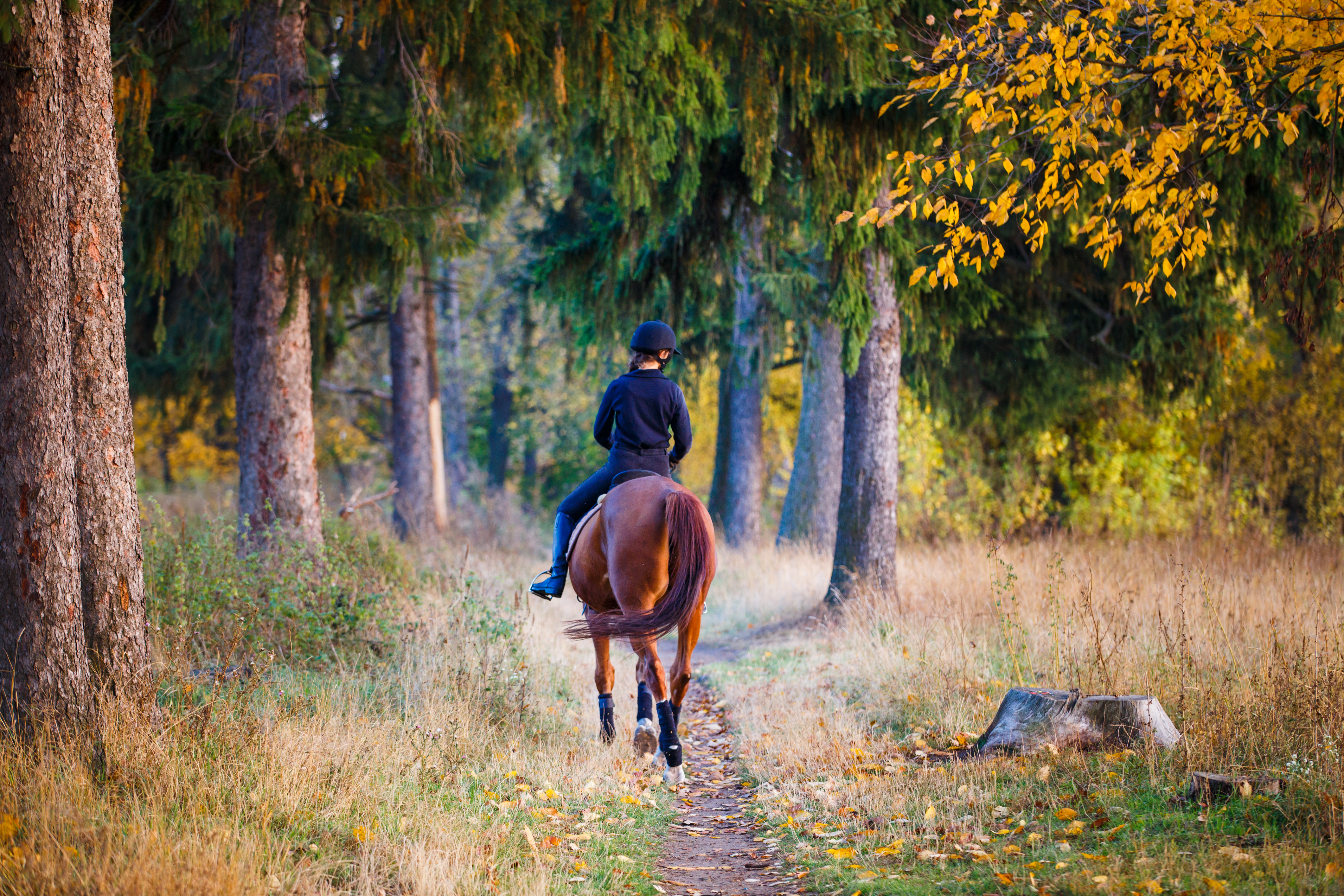
For years, I’ve enjoyed attending trail rides, horse shows and clinics with a group of like-minded friends. We’ve developed a “mobile buddy system,” helping each other out, cheering each other on and just being there to offer support when needed. I long ago became accustomed to having a friend assist me with parking my trailer, loading and unloading my horse, settling in at horse shows and generally lending a hand by sharing supplies and providing moral support when I have show-ring jitters.
Then a day I dreaded finally arrived: A show I had looked forward to for several months was on the calendar and no one in my group of friends would be able to go.
I briefly considered calling the whole thing off and waiting until the next event when at least one member of our group could go with me. But I had worked hard to prepare for this show, and I wasn’t ready to simply scratch it from my schedule. As I considered my options, I realized that I knew plenty of riders who routinely trailered their horses to shows, trail outings and other destinations on their own. Why couldn’t I? After all, I wasn’t a complete novice at shipping or showing, and I knew I could put to use the collective wisdom I had accumulated over the years of traveling with my friends. So, after careful consideration, I decided that I was ready to go it alone.
I signed up for the show, trailered my mare there and had a wonderful time. In fact, the next time I’m faced with the need to go it alone, I won’t hesitate. Still, even for veteran travelers, the prospect of trailering your horse on your own can sometimes be daunting, and it’s easy to lose track of basic trip-planning imperatives, amid all the usual horse show preparations. So, I’ve compiled a list of a few measures that gave me peace of mind on my first solo outing and that I still mentally review each time I’m traveling with my horse alone.
Like most horse owners, I do my best to keep up with regular maintenance for my truck and trailer. And on the day of an event, I make sure to start out with a full tank of fuel. These are priority items for any outing, but when you’re going it alone they assume even greater importance. Before my solo trip, I took the extra time to look over my towing rig and correct anything that looked questionable. In addition, I took an inventory of my towing vehicle and trailer emergency kits, updating them and stocking them up. I made sure I had jumper cables, for example, as well as all the tools and equipment I would need to change a tire. I found that these simple tasks gave me great peace of mind because I knew that I had done all that I could to prevent a breakdown—and I was prepared if one occurred anyway.
Go over your checklist for tack and equipment well in advance. We’ve all had that sinking feeling that comes when you discover you left an important item at home. On trips with friends, most minor items were readily replaced, either because I could borrow from someone or run out to buy an item while my friends took care of my horse. But because I would be on my own, I didn’t want to worry about finding a replacement for a forgotten item. I had always made a checklist before events, but this time I reviewed it a few days earlier than I had before; this not only ensured that nothing would be left out, but also gave me time to inspect my tack and equipment and gather spares—such as an extra bridle—where possible. By the time I was ready to leave, I had the satisfaction of knowing I had carefully worked through my list and the confidence that not even broken equipment could put a damper on my day.
Become familiar with the route and alternatives. Almost as bad as having a breakdown is getting lost while traveling to your event. GPS navigation systems, whether in your vehicle or on a smartphone, are wonderful tools, but they are not infallible. I have found it a confidence booster to carry hard copies of maps. By getting to know your route ahead of time, you’ll be better able to handle any detours or traffic issues you might encounter. Simply knowing that I had a plan for navigating detours—while still arriving by check-in time—allowed me to feel more comfortable while driving.
Assemble first aid-kits for your horse and yourself. Although both of these are necessary for any outing, when you are traveling alone they become even more important. Make certain all items in both of the kits are up-to-date and ready to use should you need them. Especially important for your horse: Make certain that you can competently administer or apply any of the items in the kit on your own. For example, I wasn’t confident about my leg bandaging technique because I had always had a friend around to help, so before my trip I spent some time practicing to make sure I could do it on my own. The very act of forcing myself to make certain that I was proficient at these skills gave me confidence that I can handle most emergencies should they arise.
Bring a mobile charger for your cell phone. When traveling alone with your horse, a cell phone is more than a matter of convenience; it can mean the difference between a quick response to an emergency or being stuck on your own for hours. Before going anywhere make certain that your cell phone battery has plenty of charge. And remember that using your phone’s GPS app can be a drain on its battery. Even if you plan to be away for only a day, bring along the charger just in case. Knowing that help was only a phone call away made my trip more enjoyable.
Establish a reasonable timetable. Allow yourself plenty of time. Without the help of friends, I quickly discovered, most of the items on my to-do list took longer to accomplish. You’ll want to allow for extra time for things like setting up your stall space, grooming your horse and preparing yourself for the day ahead. If you’ll be memorizing patterns, courses or tests and you are accustomed to having a friend along to discuss options or create a plan, setting aside some additional time to quietly go over these on your own can help reduce your stress levels.
Try to anticipate driving and towing challenges. Of course you wouldn’t attempt a solo trip if you weren’t competent at towing. But there are other tasks that you may need to do when you’re on the road. Can you change a trailer tire without assistance? Do you know how to correctly apply a set of jumper cables to a dead battery? I felt confident I could handle each of these based on my experiences traveling with friends, but if I hadn’t I would have brushed up on those skills before my trip. Review your route, and perhaps talk to horsepeople who are familiar with it, and identify waypoints that would be appropriate for stopping to check on your horse, refuel or even handle emergency situations. At the very least, look for spots with parking areas and access roads spacious enough for you to comfortably maneuver and park your rig. For added peace of mind, consider signing up with a company that specializes in providing roadside-assistance for towing.
Designate a contact at your home base.
I found it helpful to share my schedule and check in with someone at my home base from time to time. If they know when you expect to arrive at your destination or return home, they’ll know something might be amiss if you fail to check in at pre-designated times. Be sure to let them know the route you plan to travel as well as your schedule. I soon determined that preparedness led to confidence.
Scale back your schedule. Given that you won’t have a friend to help, be careful not to overextend yourself. If, for example, you will be competing at a horse show, think about reducing your number of classes. At a recent show I attended, I decided to forgo the halter and equitation classes I usually entered and instead focus on the classes that I enjoyed the most and where I knew that I had the greatest chances for success. By the end of the day, considering how tired I felt and knowing that I still had the trip home to contend with, I knew that I had made the right decision. Similarly, if I were going on a trail outing, I would consider cutting back on the distance I planned to cover. I found there was an added benefit to reducing my number of classes—I had more time to be a spectator at the show. Watching other classes made my day much more relaxing and enjoyable—and it was educational, too. I got to see how the courses rode for other riders and how they tackled problems they encountered while showing. This also gave my horse a break: While I sat in the stands my mare was able to enjoy some downtime in her rented stall, munching hay.
Use the opportunity to make new friends. The socializing opportunities presented by horse shows are part of their appeal for many of us. On my first solo journey, I quickly found that there were others who were traveling alone as well. By offering to lend a hand I was offered help in return. I ended up making several new friends that I will look forward to seeing at many events in the future.
While I was a bit more tired than usual when I returned home from my first solo show, thanks to following these tips I had a safe, successful and highly enjoyable trip. I determined that although it’s definitely more fun to travel with friends I now have the confidence to go it alone when necessary.
This article first appeared in EQUUS issue #472, January 2017.
SHARE THIS ARTICLE
Related articles.

Get the App

MEMBER SERVICE
- (800) 844-1409
- [email protected]
- Classic: (800) 877-0445
- Premier: (844) 408-1994
- 1079 S Hover St Ste 200 Longmont, CO 80501
Quick Links

HELP THOSE WHO HELP HORSES
- © 2023 USRider®
- About Horse Rookie
- Work With Us
- Write For Us
Mission Possible: Teaching Your Horse to Trail Ride Alone
As an Amazon Associate, I earn from qualifying purchases. Please read our disclosure for more info.

Have Fun Solo Strolling
One of the most incredible feelings in the world is to be out on horseback, exploring the world with your equine partner . Horses are herd animals, however, and usually don’t enjoy going out by themselves—if not taught properly.
The most important thing in reaching the goal of trail riding alone is to make you and your horse feel safe. If you can succeed at this, you’ll both be able to fully enjoy trail riding by yourselves.
In this blog post I will be going over the process of teaching a horse to trail ride alone—in peace and harmony!
When you’re ready for your first trail ride alone
To be totally confident and happy out on trail, you need to be fully confident in the arena and on the property first . If you and your horse are feeling good in the arena, you can easily check to see if your horse is ready for their first trail ride alone.
You can check on your progress by heading out within your property.
Of course, I don’t know how your barn looks, but you can even just head out into the field, or walk around the stables. If your horse stays relaxed (and you feel confident) moving slightly away from the other horses on the property, you may be ready for your first steps off property alone.
Small steps add up to long trail rides
When you’re both ready, it doesn’t mean you should immediately head out for hours on the trail. The last thing you want to do is to overface (i.e. overwhelm) an inexperienced horse . You want your horse to be excited about trail riding alone, and to be confident when something potentially spooky appears.
We’ve all ridden those ponies that are extremely slow away from home, but don’t have breaks on the way back. We don’t want our horses to show this type of behavior.
The most ideal behavior is a horse that trots out the gate, excited to go out, and whose behavior doesn’t change when you turn around to go back home.
I’ve trained my own horse in the way I am going to explain to you below, and she always trots out the gate, excited to see where we’re going today.
On the way home, she doesn’t speed up and still enjoys looking at everything around her. Occasionally she decides to walk past the barn on our way home, as she’s not ready to go home yet and wants to keep going on the trail!
Our first trail ride only lasted 2 minutes—and that’s OK!
How to make your horse excited to trail ride alone
For a horse to enjoy what they are doing, they need to feel safe, supported and protected . They should be rewarded for curiosity from the very start.
Your first solo trail ride should be extremely short, preferably between 5 and 10 minutes.
If your horse is very nervous, but has done a good job for only 2 minutes, however, it means it’s also time to go home. This will result in your horse wanting to go trail riding , as it’s such a good experience every time.
A horse that’s been on lots of competitions is likely to be less fazed by spooky stuff out on trail, while a horse that’s never been off property will have a look at everything you ride past.
In the beginning, stay close to the barn so your horse doesn’t feel completely alone and knows their friends are still nearby. This will help them build confidence.
If your horse is doing a great job, head on back to the barn and finish off with an arena ride and lots of cuddles afterwards. Doing these really short rides in the beginning will make your horse curious about all that’s out there.
If these keep going well for a few days, add a few minutes or head into another direction to see if your horse stays calm, curious and forward.
Riding in a nearby field is a great step. (Chief Rookie Aside: Always wear a helmet!)
When your horse does stop to have a look at something , stay relaxed in the saddle, give them a pat and wait for them to walk on or go towards it. If you give them enough time they will become curious. If your horse does try to turn around, don’t get angry or push them on, but just calmly steer them back so they stand in front of it again.
When they continue on walking past it, give them lots of praise and head on back.
This will teach your horse that curiosity is rewarded with lots of pets, and with going back to the barn where they feel happy and confident.
Keep adding minutes to your ride, explore different areas and allow them to be curious about everything they see. This will result in your horse wanting to go trail riding as it’s such a good experience every time.
If you push your horse past scary things without letting them have a look and be curious, they will get more and more nervous and will end up wanting to turn back when their mental bucket overflows.
It will happen that your horse starts trotting after passing a spooky or new thing, and you should definitely let this happen and even encourage it.
If you need to pull the reins to get them back into a walk, it could make your horse stressed and they might have a fright at the next thing they see.
Allow them to get rid of that excess energy by encouraging them to trot for a while, until you can easily take your horse back into a walk.
A horse that feels safe is a happy horse! Photo by ZB Fotografie (Chief Rookie Aside: Always wear a helmet!)
Food rewards on solo trail rides
Food rewards from the saddle can be a great way to help your horse gain confidence and excitement for trail riding alone. Often, horses get fed treats as soon as they arrive back at the barn, to reward them for doing so well on the trail.
Upon consideration, however, this only reinforces your horse’s unpleasant behavior of speeding up on the way home. Your horse won’t see it as a reward for a good trail ride, but as a reward for coming back to the barn.
Food rewards are an amazing tool to teach trail riding alone though.
Places where you can give your horse a treat are when they are standing and looking at something scary, this is rewarding them for being curious. You can also reward them after passing the scary thing, and switch between the two timings every now and then.
Chewing also activates your horse’s parasympathetic nervous system, which helps your horse relax and feel safe.
Checking to see if your horse takes the treat is a good way of making sure your horse is truly relaxed. You can also give your horse a food reward a few minutes before turning back, but make sure you never reward them and then immediately turn around as they will learn that a treat means they have to go home.
Give them a reward, keep walking, and maybe do a short trot, then turn around to go back home. Another important place to give your horse a treat is if they ever continue on a trail that leads further away from home, this will teach them that leaving home or going further away is a lot of fun!
Nervous horses and riders trail riding alone
If you and/or your horse are nervous , that doesn’t mean you’ll never be able to hit the trails alone. It might just mean that you’ll have to take smaller steps and take it slow.
If you are a nervous rider, I would highly recommend learning about ways you can gain confidence in the saddle first.
Also, if you or your horse are a bit nervous out on trail, read about how you can stay confident in the saddle while trail riding . There are a few things you can do to make a nervous horse more relaxed on a trail ride alone.
First of all, don’t keep a tight grip on the reins, and encourage your horse if they move into a controlled trot or canter. This allows the nervous horse to get rid of excess energy and this way they will never end up exploding.
It also makes them realize they aren’t doing anything wrong, because if you punish them for speeding up they will only become more anxious.
You’ve got this. (Chief Rookie Aside: Always wear a helmet!)
Your seat is the most important thing to make your horse feel safe on a trail ride, the reins basically shouldn’t be doing anything besides steering. If your horse gets incredibly nervous and starts to hop or dance around, pretend like nothing’s going on.
Melt into the saddle, maybe even get ridiculously loose in your shoulders and hips to the point of looking like a rag doll.
Don’t grab onto the reins to stop them, only to turn them to face the thing that’s making them anxious, and when they’ve had a good look, continue on.
If they keep dancing around, just keep pretending to be the most relaxed person on the planet, your horse will quickly realize that you aren’t scared of the same thing as they are and calm down.
I hope you’ve enjoyed these tips for setting your trail ride up for success!
P.S. If you enjoyed this article, trot on over to:
- Happy Trail Gear Guide: What to Wear Horseback Trail Riding
- 7 Best Stirrups for Trail Riding in All-Day Comfort
- 7 Best Boots for Horse Trail Riding in Harmony
- Ultimate Beginner’s Guide to Horseback Trail Riding at Night
- 5 Best Horse Bits for Trail Riding Success
- 7 Best Satellite Phones for Horse Riders Who Need Help NOW
- 6 Best Saddle Pads for Trail Riding and Happy Horses
You may also like
Beyond blue jeans: 10 creative ways to style tecovas..., the best uv protection under the sun (horses &..., how to get the most out of virtual horse riding lessons, a safe bet: choosing the perfect horse tack &..., how to pick the perfect western horse show pad, what to do when your horse ride goes wrong, about the author, sanne westera.
I'm a 22 year old travel fanatic, nature lover, and overall horse enthusiast. I’ve been riding ever since I was a kid and quickly became an avid dressage rider and went up all the national levels in the Netherlands with my previous horse Zappy. In 2015, I made a major switch, and have since been a horse trails guide in several countries in Europe and Africa. Read all about horse travel, working, and volunteering with horses on my website www.hoovesaroundtheworld.com.
Enjoy Free U.S. Shipping On Orders Over $50*
Country/region
- USD $ | Afghanistan
- USD $ | Åland Islands
- USD $ | Albania
- USD $ | Algeria
- USD $ | Andorra
- USD $ | Angola
- USD $ | Anguilla
- USD $ | Antigua & Barbuda
- USD $ | Argentina
- USD $ | Armenia
- USD $ | Aruba
- USD $ | Ascension Island
- USD $ | Australia
- USD $ | Austria
- USD $ | Azerbaijan
- USD $ | Bahamas
- USD $ | Bahrain
- USD $ | Bangladesh
- USD $ | Barbados
- USD $ | Belarus
- USD $ | Belgium
- USD $ | Belize
- USD $ | Benin
- USD $ | Bermuda
- USD $ | Bhutan
- USD $ | Bolivia
- USD $ | Bosnia & Herzegovina
- USD $ | Botswana
- USD $ | Brazil
- USD $ | British Indian Ocean Territory
- USD $ | British Virgin Islands
- USD $ | Brunei
- USD $ | Bulgaria
- USD $ | Burkina Faso
- USD $ | Burundi
- USD $ | Cambodia
- USD $ | Cameroon
- USD $ | Canada
- USD $ | Cape Verde
- USD $ | Caribbean Netherlands
- USD $ | Cayman Islands
- USD $ | Central African Republic
- USD $ | Chad
- USD $ | Chile
- USD $ | China
- USD $ | Christmas Island
- USD $ | Cocos (Keeling) Islands
- USD $ | Colombia
- USD $ | Comoros
- USD $ | Congo - Brazzaville
- USD $ | Congo - Kinshasa
- USD $ | Cook Islands
- USD $ | Costa Rica
- USD $ | Côte d’Ivoire
- USD $ | Croatia
- USD $ | Curaçao
- USD $ | Cyprus
- USD $ | Czechia
- USD $ | Denmark
- USD $ | Djibouti
- USD $ | Dominica
- USD $ | Dominican Republic
- USD $ | Ecuador
- USD $ | Egypt
- USD $ | El Salvador
- USD $ | Equatorial Guinea
- USD $ | Eritrea
- USD $ | Estonia
- USD $ | Eswatini
- USD $ | Ethiopia
- USD $ | Falkland Islands
- USD $ | Faroe Islands
- USD $ | Fiji
- USD $ | Finland
- USD $ | France
- USD $ | French Guiana
- USD $ | French Polynesia
- USD $ | French Southern Territories
- USD $ | Gabon
- USD $ | Gambia
- USD $ | Georgia
- USD $ | Germany
- USD $ | Ghana
- USD $ | Gibraltar
- USD $ | Greece
- USD $ | Greenland
- USD $ | Grenada
- USD $ | Guadeloupe
- USD $ | Guatemala
- USD $ | Guernsey
- USD $ | Guinea
- USD $ | Guinea-Bissau
- USD $ | Guyana
- USD $ | Haiti
- USD $ | Honduras
- USD $ | Hong Kong SAR
- USD $ | Hungary
- USD $ | Iceland
- USD $ | India
- USD $ | Indonesia
- USD $ | Iraq
- USD $ | Ireland
- USD $ | Isle of Man
- USD $ | Israel
- USD $ | Italy
- USD $ | Jamaica
- USD $ | Japan
- USD $ | Jersey
- USD $ | Jordan
- USD $ | Kazakhstan
- USD $ | Kenya
- USD $ | Kiribati
- USD $ | Kosovo
- USD $ | Kuwait
- USD $ | Kyrgyzstan
- USD $ | Laos
- USD $ | Latvia
- USD $ | Lebanon
- USD $ | Lesotho
- USD $ | Liberia
- USD $ | Libya
- USD $ | Liechtenstein
- USD $ | Lithuania
- USD $ | Luxembourg
- USD $ | Macao SAR
- USD $ | Madagascar
- USD $ | Malawi
- USD $ | Malaysia
- USD $ | Maldives
- USD $ | Mali
- USD $ | Malta
- USD $ | Martinique
- USD $ | Mauritania
- USD $ | Mauritius
- USD $ | Mayotte
- USD $ | Mexico
- USD $ | Moldova
- USD $ | Monaco
- USD $ | Mongolia
- USD $ | Montenegro
- USD $ | Montserrat
- USD $ | Morocco
- USD $ | Mozambique
- USD $ | Myanmar (Burma)
- USD $ | Namibia
- USD $ | Nauru
- USD $ | Nepal
- USD $ | Netherlands
- USD $ | New Caledonia
- USD $ | New Zealand
- USD $ | Nicaragua
- USD $ | Niger
- USD $ | Nigeria
- USD $ | Niue
- USD $ | Norfolk Island
- USD $ | North Macedonia
- USD $ | Norway
- USD $ | Oman
- USD $ | Pakistan
- USD $ | Palestinian Territories
- USD $ | Panama
- USD $ | Papua New Guinea
- USD $ | Paraguay
- USD $ | Peru
- USD $ | Philippines
- USD $ | Pitcairn Islands
- USD $ | Poland
- USD $ | Portugal
- USD $ | Qatar
- USD $ | Réunion
- USD $ | Romania
- USD $ | Russia
- USD $ | Rwanda
- USD $ | Samoa
- USD $ | San Marino
- USD $ | São Tomé & Príncipe
- USD $ | Saudi Arabia
- USD $ | Senegal
- USD $ | Serbia
- USD $ | Seychelles
- USD $ | Sierra Leone
- USD $ | Singapore
- USD $ | Sint Maarten
- USD $ | Slovakia
- USD $ | Slovenia
- USD $ | Solomon Islands
- USD $ | Somalia
- USD $ | South Africa
- USD $ | South Georgia & South Sandwich Islands
- USD $ | South Korea
- USD $ | South Sudan
- USD $ | Spain
- USD $ | Sri Lanka
- USD $ | St. Barthélemy
- USD $ | St. Helena
- USD $ | St. Kitts & Nevis
- USD $ | St. Lucia
- USD $ | St. Martin
- USD $ | St. Pierre & Miquelon
- USD $ | St. Vincent & Grenadines
- USD $ | Sudan
- USD $ | Suriname
- USD $ | Svalbard & Jan Mayen
- USD $ | Sweden
- USD $ | Switzerland
- USD $ | Taiwan
- USD $ | Tajikistan
- USD $ | Tanzania
- USD $ | Thailand
- USD $ | Timor-Leste
- USD $ | Togo
- USD $ | Tokelau
- USD $ | Tonga
- USD $ | Trinidad & Tobago
- USD $ | Tristan da Cunha
- USD $ | Tunisia
- USD $ | Türkiye
- USD $ | Turkmenistan
- USD $ | Turks & Caicos Islands
- USD $ | Tuvalu
- USD $ | U.S. Outlying Islands
- USD $ | Uganda
- USD $ | Ukraine
- USD $ | United Arab Emirates
- USD $ | United Kingdom
- USD $ | United States
- USD $ | Uruguay
- USD $ | Uzbekistan
- USD $ | Vanuatu
- USD $ | Vatican City
- USD $ | Venezuela
- USD $ | Vietnam
- USD $ | Wallis & Futuna
- USD $ | Western Sahara
- USD $ | Yemen
- USD $ | Zambia
- USD $ | Zimbabwe

Item added to your cart
Traveling with horses: 11 long-distance trailering & travel tips.
Long-distance travel with your horse can be challenging. Whether heading to a competition, moving to a new location, or embarking on an adventure, careful planning and preparation are key to ensuring a safe and comfortable trip for you and your horse. In this blog, we’ll explore essential tips, considerations, and practical advice to help you navigate the intricacies of traveling long distances with your horse, from health and safety precautions to logistical planning and everything in between.
11 travel tips and necessities when traveling with horses
Traveling with horses requires prepping in advance to ensure the safety and well-being of your horses. Here’s a list of essential items you’ll need, as well as tips and considerations for a long-distance journey with your horse.
1. Use the right horse trailer
The most important thing you’ll need is a suitable mode of transportation to transport your horses from one location to another safely–in this case, a horse trailer . The horse trailer size and style needed will depend on how many horses you have and your towing vehicle. Ensure your horses are safely secured within the trailer or transport vehicle with appropriate restraints to prevent injury or accidents during transit.
Learn more: How to Choose the Right Style and Size Horse Trailer
2. Pack proper tack and equipment
Whether moving your horses to a new permanent location or traveling to a show, you’ll need your horses’ tack and equipment. This includes saddles , bridles , halters , lead ropes , and other equipment for riding or handling your horses. You may also want to use protective boots or wraps for your horses’ legs to prevent injuries during transportation.
Also, consider the weather conditions at your destination and bring appropriate gear, like blankets or fly masks , to protect the horses from extreme temperatures, rain, or insects.
3. Provide access to feed and water
Preparing feed and water is vital when traveling long distances with horses. You should maintain your horses’ regular feeding schedule as much as possible. A hay net stocked with fresh hay in the trailer will keep your horses fed throughout the journey. Even if your commute is relatively short, plan for hydration stops since horses should not go more than a few hours without water.
Learn more: Horse Hydration 101: How Much Water Should Your Horse Drink in a Day
4. Use bedding
Standing on a hard surface for hours can be challenging for anyone, horses included. Consider adding bedding for the trailer to keep your horses comfortable during the journey. Bedding can also absorb urine and keep the trailer sanitary. If you use bedding prone to dust, you may also want to add a fly mask to avoid respiratory issues.
5. Carry health documents and identification
Make sure your horse is healthy enough to travel and that you have all necessary health documents, including Coggins tests, health certificates, and vaccination records when traveling, especially if crossing state or international borders. Carry proper identification for each horse, such as microchips, ID tags, or markings on the horse’s body, to facilitate identification in case of separation or emergency.
6. Bring grooming supplies
If you’re traveling for a show or competition, you want to make sure your horse looks its best after the journey. Bring brushes, combs, hoof picks, and other grooming supplies that will help freshen your horse up after traveling. Stay ready no matter what with a travel grooming kit .
7. Pack emergency supplies
Don’t forget to pack a well-stocked first aid kit specifically designed for horses , including wound dressings, antiseptic solutions, bandages, and medications. Carry extra supplies such as extra water, hay, and emergency repair materials for the trailer or vehicle in case of unexpected delays or breakdowns. Stay prepared for anything by keeping a list of emergency contact numbers for veterinarians, farriers, and other relevant authorities along the route.
8. Provide proper ventilation
Proper ventilation is essential to prevent overheating and respiratory issues during transportation. Ensure that the trailer or transport vehicle has adequate airflow, and consider using fans or opening windows if necessary. This is incredibly important in hot and humid weather .
Frequent breaks can help horses clear their respiratory passages from dust and debris. Low-dust or shavings bedding is also essential, especially for horses prone to respiratory problems.
Learn more: How to Keep Your Horse Cool in a Trailer
9. Keep an eye out for shipping fever
Shipping fever, or transport stress pneumonia or shipping pneumonia, is a respiratory condition affecting horses during or shortly after transportation. It typically occurs when horses are subjected to the stress of long-distance travel, especially in poorly ventilated trailers or under other conditions that compromise their respiratory health.
Preventing shipping fever involves minimizing stress and maintaining optimal conditions for the horse during transportation. Ensure proper ventilation within the trailer, Provide ample bedding, offer frequent rest breaks, and closely monitor the horse’s condition throughout the journey. Additionally, vaccinating horses against common respiratory pathogens and practicing good biosecurity measures can help reduce the risk of shipping fever.
Learn more: 17 Signs and Symptoms of a Sick Horse
10. Plan your route in advance
Plan your route carefully to ensure you have suitable places to stop for breaks along the way. When planning your travel route, it’s a good idea to identify potential stopping points in advance and have backup options in case your original plans need to change. Prioritize locations that offer safe, accessible parking and amenities that meet your and your horses’ needs.
11. Allow adequate recovery time
Once you’ve reached your destination, give your horses plenty of time to recover from extensive time on the road. Allow them to stretch their legs and move freely, if possible. Monitor them for any changes to their behavior or food intake, and call a veterinarian if they refuse to feed or have an elevated temperature.
How long can a horse stand in a trailer?
Ideally, horses should not exceed six to nine hours in a trailer without a break, depending on how much food and water you provide them. During long journeys, take breaks every four to six to check on your horses or let them rest and rehydrate. Breaks allow horses to relieve themselves, adjust their posture, and alleviate discomfort from prolonged standing. If traveling more than 12 hours, consider stabling your horse overnight to prevent fatigue and illness.
While horses spend most of their lives on their feet, don’t expect your horse to power through a 12-hour ride without breaks. The length of time a horse can stand in a trailer depends on several factors, including the individual horse’s temperament, health, comfort level, conditions inside the trailer, and the overall duration of the journey.
It’s essential to monitor your horses closely during transit, paying attention to their behavior, body language , and overall well-being. Signs of stress or discomfort, such as pawing, sweating, restlessness, or excessive vocalization, may indicate that the horse needs a break or that you need to adjust their travel conditions.
Places to stop when traveling with horses
Plan your travel route ahead of time and map out any potential break areas where you can stop and tend to your horses. Here are some options for places to stop when traveling with horses.
Many highways and major roads have designated rest areas with restrooms, picnic areas, and ample parking spaces. These areas can provide a safe and convenient place to take breaks with your horses.
Truck stops
Truck stops often have ample parking space for trailers and provide fuel, food, water, and restroom facilities. While not specifically designed for horses, they can be suitable for short breaks during long journeys.
Equestrian facilities
Look for equestrian facilities or horse-friendly rest stops along your route that specifically offer hitching posts, watering stations, and even overnight stabling or turnout areas for horses if traveling long distances.
Public parks
Some public parks or recreational areas allow horse trailers and offer trails or open spaces where horses can stretch their legs and graze during breaks. Check for any restrictions or regulations before stopping at a public park.
Fairgrounds or event centers
Fairgrounds and event centers with horse facilities may allow travelers to use their grounds for rest stops. These venues often have large parking areas, water sources, and sometimes even horse stalls or turnout areas.
Private properties
You can stop at private properties for breaks if you have connections or arrangements with friends, family, or acquaintances along your route. Just be sure to get permission in advance and respect the property owner’s rules and guidelines.
In it for the long haul
Traveling with your horses can be challenging, but with proper planning, you and your horse can take the journey in stride. If you have questions about which horse trailer is right for a long-distance trip, Ken Feagin and his team have the answers! Give them a call or stop by to see their horse trailer selection in Campobello, SC!
Shop all horse trailers today →
You might also like:
- 6 Best Horse Trailers with Living Quarters
- Ultimate Guide to Horse Trailer Weights, Types, and Sizes
- Ultimate Horse Show Checklist
Michelle has been obsessed with horses since childhood. In addition to managing the e-commerce department at Farm House Tack, she is a graduate B with the United States Pony Club and previously worked as an Equine Veterinary Technician. She currently competes in the Amature Owner Hunters with her home-bred warmblood gelding Lego. Her husband David is a DVM with a graduate degree in medical microbiology from the University of Georgia.
Leave a comment
Please note, comments need to be approved before they are published.
- Choosing a selection results in a full page refresh.
- Opens in a new window.

Signs of Loneliness in Horses: Do Horses Get Lonely + How To Help
By: Author April Lee
Posted on Last updated: 11/14/2023
Sharing is caring!
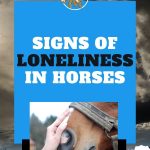
Horses do get lonely if they don’t have interaction with other horses or humans. Key signs of loneliness like restlessness, loss of appetite/weight loss, and stress behaviors like kicking, cribbing, calling, and sweating can all be signals of stress from isolation.
This can lead to bigger issues down the line, but there are some ways you can help by offering an emotional support animal and more interaction to your horse with enrichment activities or horse play-dates.
Table of Contents
Key Takeaways
- The 5 most common signs of loneliness in horses are 1) pacing/restlessness 2) loss of appetite/weight 3) calling or whinnying 4)cribbing and 5)excess kicking. Sweating or lack of normal reactions can also be indicators.
- To ease or treat loneliness in a horse, consider adding a smaller animal for company , like a goose or cat, and put mirrors up so that the horse can see itself ( source ).
- There is no substitute for real human or horse interaction for a horse long-term , and continued isolation can lead to depression.
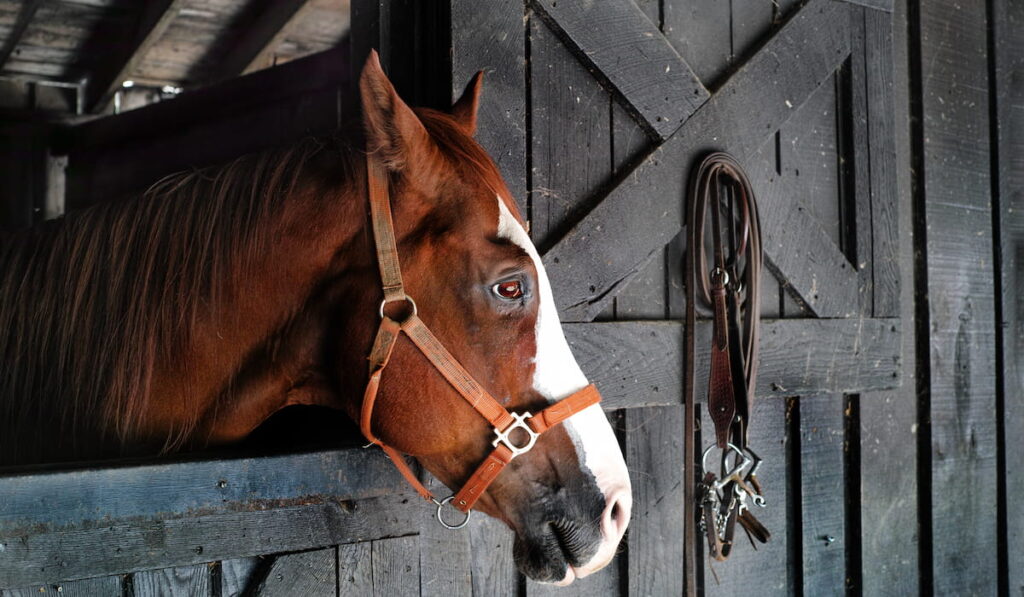
What Are Signs of Loneliness in Horses?
According to equine experts, understanding horse behavior is essential to prevent issues like depression in horses and stress responses caused by feeling alone or social isolation ( Reference: Katherine Reid, Chris W. Rogers, Journal of Veterinary Behavior Vol 22, 2017, P 1-6 ).
Horses, being social animals , often exhibit distinct signs of loneliness, which, if not addressed, can lead to adverse health effects. In the following table, we’ll present the most common signs of loneliness or isolation in horses. After that, we’ll delve into these behaviors in more detail, so you can ensure your horse’s mental well-being in the stable or paddock .
Since horses are ultimately a prey animal , they have a fight-or-flight response that is affected by their feeling of social safety or protection. Domesticated horses may be safe, but their physiology doesn’t know they’re a draft horse that simply isn’t needed much during winter (for instance).
Over time, isolation will drive anxiety and fear in the horse, leading to physiological stress responses that can raise cortisol levels in the horse’s bloodstream, affecting blood pressure, blood sugar, and immune system performance . Interaction, on the other hand, releases endorphins as the normal/social interactions soothe the horse’s parasympathetic nervous system. ( source: Wikipedia )
Lack of Reactions
Just like humans, when horses are lonely, they can become depressed. Also just like humans, a common symptom of depression is becoming withdrawn, uninterested or unaware in situations around them.
You can tell when your horse is withdrawn, as it will tend not to respond to things around it.
For example, a study was done with 50 horses in which unusual animal sounds were played. The horses that were not perceived to be lonely and depressed reacted with interest, curiosity or even trepidation.
Their ears pricked up, their heads turned to the sound, and they licked their lips in concentration on the new thing. The lonely horses, though, registered no reaction. They did not acknowledge something new and strange, and they seemed unaware of it.
You do not need to conduct your own study to notice horses that don’t react. These horses will usually stay still for a long time; their ears, too, will not move for lengths of time. Their heads and necks will remain fixed, and their eyes tend to be open, but wide and unfocused, with a long time between blinks.
Pacing or Restlessness
If your horse constantly paces back and forth at the fence line, that is an important sign of loneliness. It may be that there are no other horses or animals at the barn and so it sticks to the outside of the pasture out of boredom and hope. It also may be that it has a buddy who is in a separate field or who is kept in a stall.
Pacing is not only a bad sign for mental health, but it can also lead to physical health problems as well. Pacing puts extra strain on a horse’s legs, which can lead to joint and tendon damage caused by repetitive motion.
Another risk is ringbone (a type of arthritis in the horse’s lower leg), as constant turning strains the joints.
Your horse may not be strictly pacing in a “back and forth at the fence line” sense, but it could be just generally restless. If your horse is overly fidgety, walking in circles, or keeps stamping its hooves – all these are signs of restlessness that arise when a horse is bored.
If your horse doesn’t have a friend to keep it company and its mind occupied, it may show these bored, restless motions, much like a toddler who is under-stimulated.
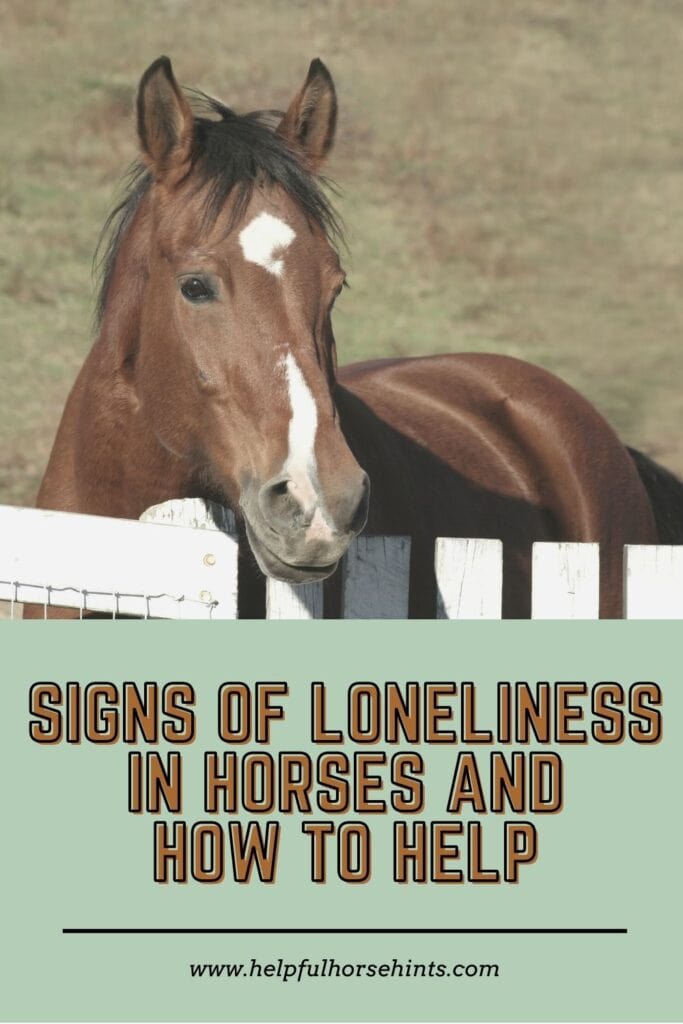
Living in a stall is unnatural for a horse. Horses are naturally used to open spaces and not confinement – and they aren’t used to being separated from their herd. Apart from necessary stall rest for sickness or injury, horses shouldn’t be kept confined.
A horse that is alone in a stall will often call out. The sound is not like typical neighs and whinnies – the call is not only sharper and more urgent, but it will also be excessively repeated. Lots of whinnying is a cry for help and a cry for friendship.
This stressor can lead to other physical manifestations, too, such as stomach ulcers . Ulcers in the horse’s stomach and colon can affect a horse’s appetite, causing weight loss, a dull coat, a loss of interest in work, behavioral issues, and more.
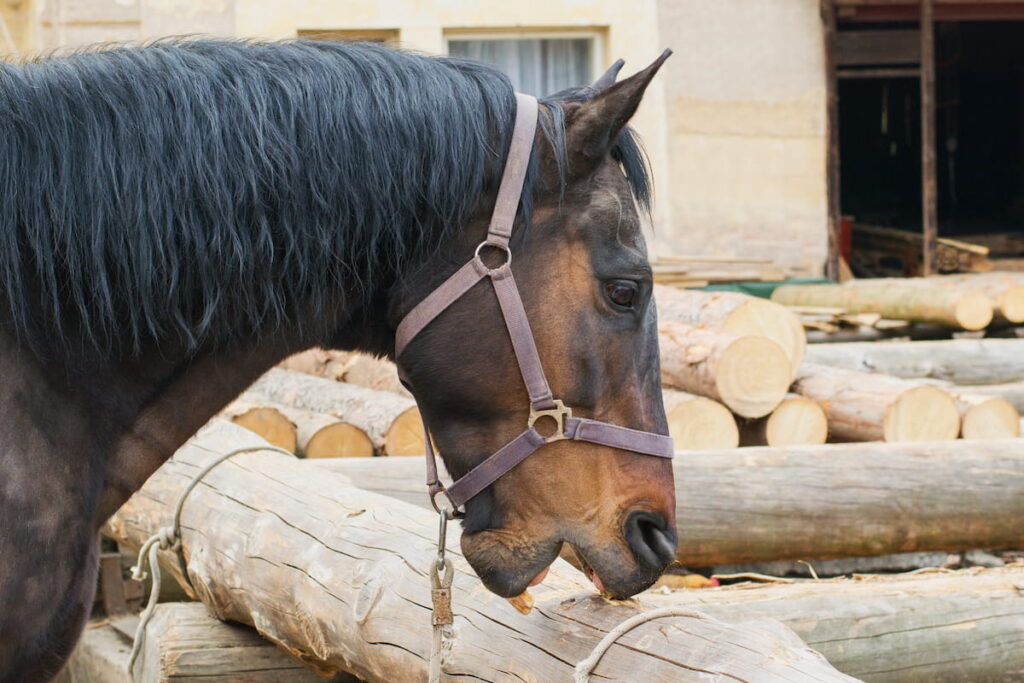
Cribbing is when a horse compulsively bites a fence rail (or something similar). A cribbing horse may also “wind suck,” where it arches its neck and sucks in, contracting its lower neck muscles as air rushes in. You will hear an accompanying grunt with most cribbing.
This is an addictive and fixating behavior that often occurs when a horse is bored or lonely. If a horse is kept on its own, its mind can become overwhelmed by boredom, stress, and loneliness, resulting in this neurotic behavior to cope.
Loss of Appetite
Lonely horses may not eat as much as they would under normal circumstances. They are often not interested in food anymore, as their minds are more focused on feeling lonely.
This also connects to a restless nature, as more time spent pacing or fidgeting is time spent not eating. And, if they are on edge about being alone, they often just won’t feel as hungry.
While loneliness isn’t a direct physical threat, it still triggers the stress of the “fight or flight” reaction, which dampens the appetite and heightens the horse’s state of alert.
A horse who is generally even-tempered may develop some bad habits when left alone. Sometimes, sadness and loneliness in horses can manifest as anger or frustration.
You may notice your horse kicking at the stall because they have pent-up social energy with nowhere and no one to spend it on. This does not mean the horse is aggressive or badly behaved generally, but it is a warning sign that it is becoming agitated by loneliness and stress, which can cause behavior problems if left unchecked.
Bucking behavior can be considered similar to kicking as a signal here. See our related article on 9 Reasons Your Horse is Bucking for more.
Excessive sweating is a stress behavior in horses, and as we’ve seen being alone can cause horses to feel stressed. If it is a normal, cool day and your horse has not been exercising yet it is sweating, which is most likely stress sweat .
Just like humans who can have “nervous sweating” in response to a high-stress situation, horses who are alone and unhappy about that can react with stress sweat in a similar way. And note that foaminess of the sweat is pretty natural (see our related resource on horse sweat and foam ).
How You Can Help A Lonely Horse? Most Popular Stress Prevention Tactics
Having another horse can be expensive, but luckily horses are rather sociable with many animals. You might consider a different farm friend for your horse, such as a donkey, llama, cow – even a goose! An “emotional support animal” for your horse works wonders.
You can also simply add some mirrors around the stable –adding mirrors has been shown to ease social isolation and stress in horses (reference: Rachel Kay, Carol Hall-Applied Animal Behaviour Science, Volume 116, Issues 2–4 ).
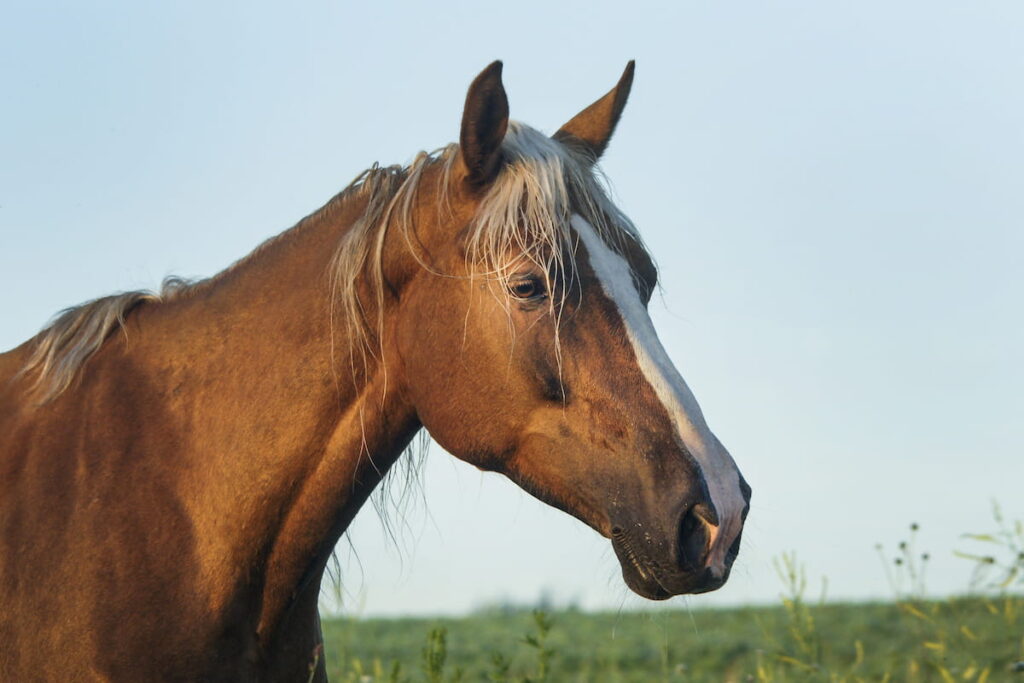
Another option to consider is taking on a senior horse. Older horses who can no longer be ridden have a harder time finding homes, but that doesn’t mean they aren’t still full of life and love!
Senior horses don’t require tack, they don’t suffer riding-related injuries and they eat less. Adopting a senior horse as a pasture pal not only keeps your current horse happy with a friend, but it gives a deserving older equine a loving home to live out the rest of their years.
As creatures with great social intelligence, a horse kept by itself can be a lonely one indeed. Though not all horses are the same (some do better with being alone than others), you will want to observe your horse and know what to look for if it does start feeling lonely.
While horses and humans have a long history of being excellent companions for each other, a human can’t fulfill all of a horse’s social needs, just as a horse doesn’t fulfill all the social needs of a person. If your horse is showing signs of being unhappy being alone, don’t take it personally – but do look into providing them with a friend, whether it’s a horse or another companion animal .
Frequently Asked Questions
Can horses live alone without other horses.
Horses can live alone, but if your horse is alone, it is important to provide sufficient mental and physical stimulation to prevent stress and loneliness. The most effective way to ensure their well-being and eliminate loneliness is by regular human interaction, enrichment activities, and, if possible, occasional contact with other horses.
Do Horses Get Bored? (Boredom vs. Loneliness in Horses)
Yes, horses can get bored , especially when they lack mental and physical stimulation. Boredom in horses is different from loneliness , though they can overlap. A bored horse may engage in repetitive behaviors or seem lethargic , while a lonely horse often shows signs of distress and seeks companionship.
How Do You Know If Your Horse Is Sad?
You can tell if your horse is sad by observing changes in behavior. Signs of sadness in horses include lack of interest in surroundings, reduced interaction with humans or other horses, changes in eating or sleeping patterns, and a general decrease in activity levels. These signs, especially when persistent, indicate emotional distress. If your horse seems sad, consider if loneliness could be the cause.

Subscribe To Our Newsletter
Join our mailing list to receive the latest updates as well as get access to the FREE resource library !
You have Successfully Subscribed!

13 Tips for Loading a Difficult to Load Horse
By Anne Forsberg
Published on November 12, 2020
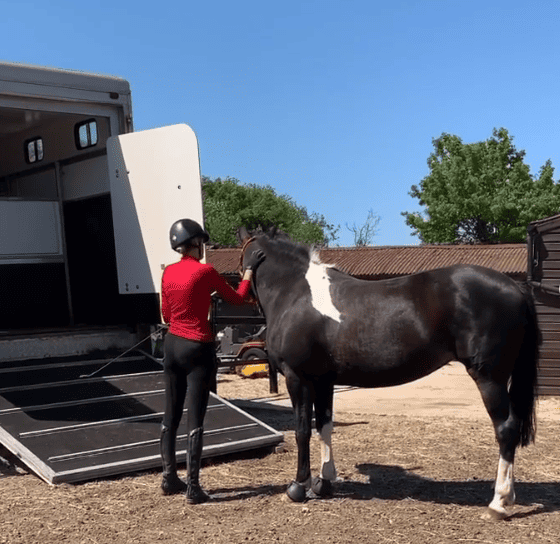
How well a horse loads and travels is always a key consideration at purchase, after all, if the horse won’t travel happily then this can cause huge issues if you want to train or compete or even just go to the vets.
- Why are some Horses Difficult to Load?
There are lots of reasons why horses are difficult to load and some of these include:-
- A poor or inadequate introduction to loading as a young horse
- A previous bad experience which might have been an accident, poor handling techniques or bad driving
- Some horses take exception to certain types of transport and not others so, for example, some horses will not travel on trailers but are fine on lorries
- Some horses simply worry more about loading and travelling than others
- Potential Issues
Horses can have issues about lots of different aspects of loading and travelling and it is important to work out exactly what it is that is worrying your horse. Here are a selection of things that horses can dislike or worry about and which may make them reluctant to load or downright impossible:-
- Walking into a confined space that is darker than outside
- Walking on ramps which are hollow
- Loading on steep ramps
- Turning round in the lorry to come down the ramp
- Needing a narrower or wider space – some horses need the entire area of the trailer and have to travel with the partition out and cross ties
- Struggling to balance when in motion, this is connected to how horses travel and the space they need but it can make some horses refuse to load at all
- 13 Tips to Help You Load a Difficult Horse
There is a massive amount of information online about how to load difficult horses as it is a very common problem and can be challenging to solve. Here are 13 tips to help you load a difficult horse.
- Put the proper groundwork in place – if the horse will not lead properly in hand and either drags along behind you or barges then he is very unlikely to load onto a lorry or trailer. The horse must respect the handler. It also helps if you have a good bond with the horse.
- Have the right equipment – This needs to be planned in advance. For example some horses need to wear a bridle to load whereas other people use a pressure halter. You might want to lead on a lunge line rather than a lead rope as it is longer and gives you more options if the horse is being difficult
- If nervous ask someone else to load – A naughty horse will immediately play up a handler who is lacking in confidence, a nervous horse will become even more worried
- Try and identify what is specifically worrying your horse – it could be easy to resolve like leaving the front of the trailer open for light whilst you load or taking the central partition out
- Always park the vehicle in a safe and sensible location so that both the horse and the handlers are as risk-free as possible. Parking near a wall can help block off one route of escape or use the corner of a field or arena. It is important that the footing around the vehicle is level and not slippery
- Line up so Horse Faces the Ramp – Whatever the issue, always try to keep your horse facing the ramp and not turning away from it – the same principle which applies to jumping. You are over halfway there if you can keep the horse straight and facing the vehicle
- Get Somebody to Help You – If you have a tricky loader then you will need help as it is almost impossible to do it alone and it is certainly not safe. Ask for help from a quiet and calm horse person, don’t bring the crowd scene, it will just upset the horse and everyone will try and add their opinion which may not help
- Park in a Quiet Location – If you have a horse who is difficult to load coming home, always try and park in a quiet location at the event or show. People often tend to congregate near a difficult loader and start trying to help, it may be well-intentioned but it can cut across what you are trying to do and just add stress to the situation
- Avoid Negative Reinforcement – Don’t train through negative reinforcement, give the horse the options and make him accountable for his own behaviour. Negative reinforcement may work for a while but it won’t last
- Don’t Give Up – Try and stick with it no matter how long it takes
- Change type of transport – Some horses only refuse to load on certain types of transport, this is not necessarily a cheap answer but it can provide a solution
- Use a long rope or line -This allows the horse to move around if he needs to and is ultimately safe if he behaves unpredictably
- Repeat, Repeat, Repeat – Once you have solved the issue you need to solidify the good behavior through repetition
You are not going to solve the problem of a bad loader on the morning that you either want or need to take the horse somewhere. It is better to accept that you won’t be going somewhere for a while and spend time at home trying to resolve the issue.
If you lack experience then find some professional help to assist you, that could be your instructor or a friend who is experienced and competent or there are people who advertise their services specifically as experts to help with problem horses. Make sure you research very thoroughly anyone you don’t know and who is not directly recommended to you by someone you trust.
- Top Tips to remember with loading
- Never load in a hurry even with a good loader, take your time and always allow enough time to do the job
- If you are out of depth then get in some professional help, it will ultimately be much quicker and safer
- Try not to make the situation combative no matter how frustrating it becomes – once the horse realises that his size and strength are in his favour, it is very difficult to win the argument

About Anne Forsberg
Anne has been riding since she was only 5 years old and she's been obsessed with horses ever since. An avid horsewoman now, she loves horses and this sport more than anything else, sharing stories and info that she hopes will be helpful and meaningful to anyone who's on their path to become a better horse owner, a better rider and why not, a better person. Learn more about Seriously Equestrian's Editorial Process .
More from Seriously Equestrian

How to make homemade fly spray for your horse
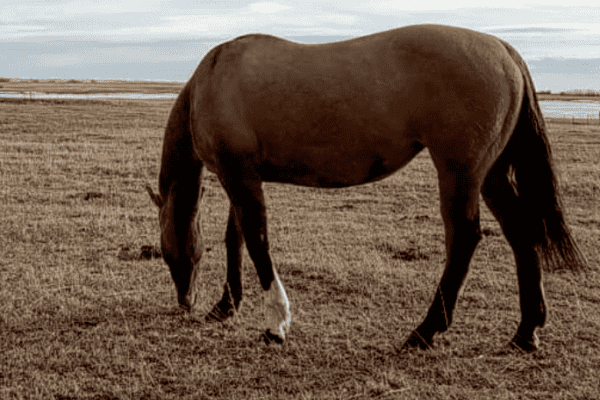
6 Signs That it Might be Time to Sell Your Horse

Horse Manes: Everything You Should Know
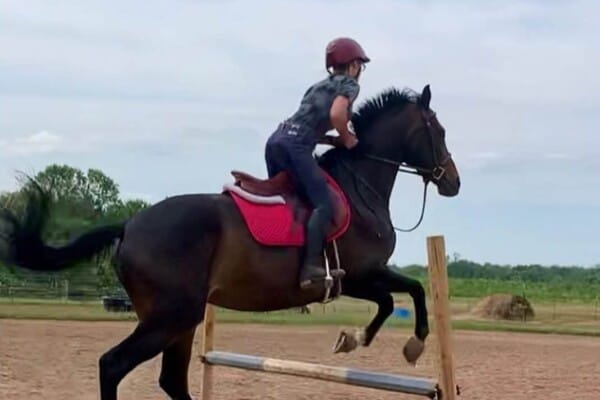
19 simple tips for horse jumping beginners
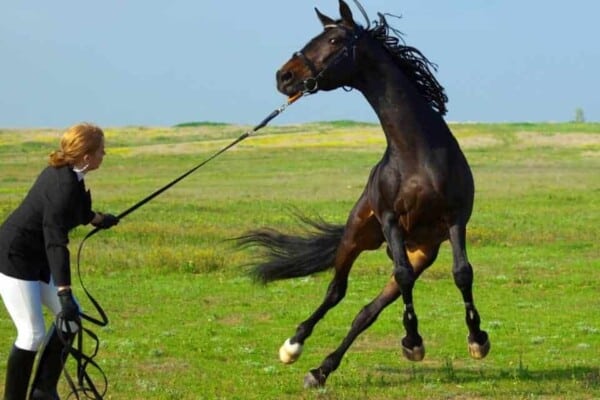
10 Ways to Calm a Nervous Horse

How Long do Horses live?
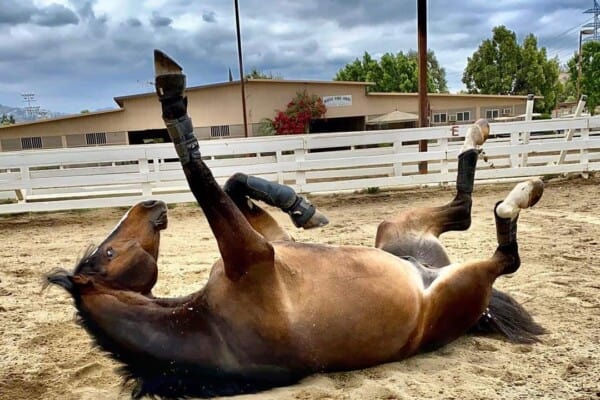
Why do horses roll? Different reasons explained

The Top 5 Non-human Companions for a Horse
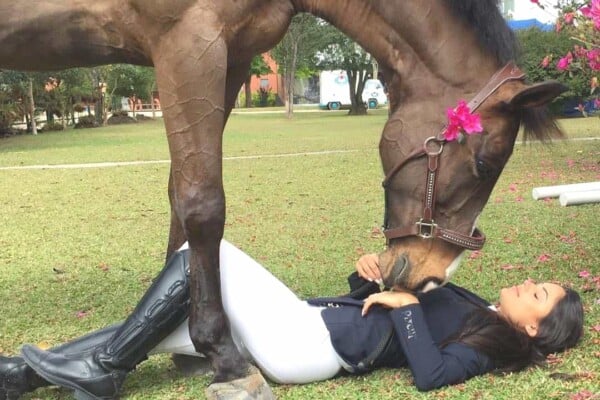
11 Ways to Improve Your Bond With Your Horse
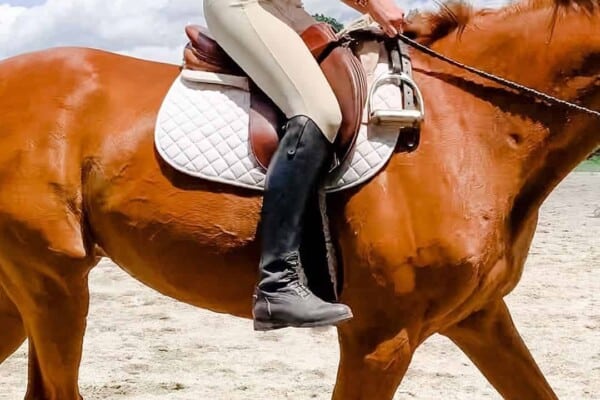
17 tips to improve your riding without Stirrups
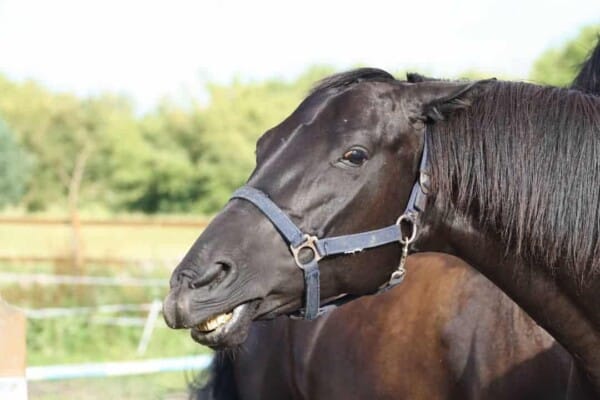

15 Telltale Signs of Stress in Horse
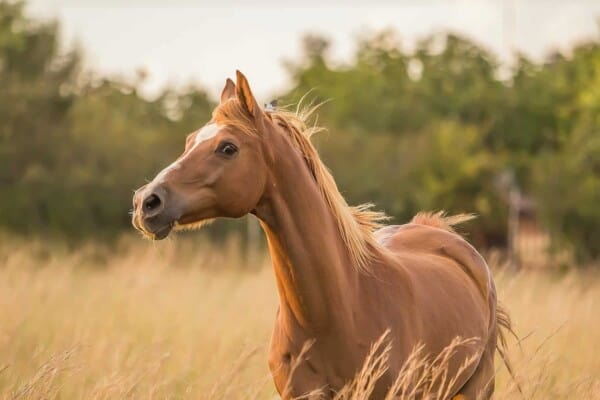
25 Horse Markings and Their Meaning
By Alex Verwest

- Search forums
- HHO Archive
- Tack Room Archive
does anyone have a horse/pony who wont travel on there own?
- Thread starter westparc
- Start date 8 September 2009
- 8 September 2009
Well-Known Member
does anyone else have a horse or pony who wont travel on there own what do you do? how sucessful have you been with travelling with any techneques?
Mine will travel fully tacked up to go out on a hack on his own but will not go to a show on his own! I have borrowed an outgrown pony from a friend who comes to shows (put first in box) and it works well. He will walk away from the travelling companion without a care in the world. I must just own a wierdo !
i thourght about borrowing a pony but dad doesnt want to tow 2 so it looks like he wont tow any!!!!
what does the pony do when travelling alone ? I wouldnt know if mine like travelling alone or not cause I just bung them in - shut the ramp and go and they have to like it or lump it basically.
arwenplusone
we havent got that far! last time we shut the ramps she started double barreling them!! and pushing on the sides as much as she could so the sides start flexing so begins to stand as diagonally as she can to create more force and shakes (she did this today even with the ramps down it seems to be when she is on her own when we have left the trailer and cant see anyone the thing is i really worry because she has torn her superficial flexor tendon on her right hind and her anular ligament on her left hind
Mine doesn't like travelling on her own. I have a lorry and the door from the horse-area into the living is a half-door (like a stable door), by tying the top half back, my horse can see me driving the lorry and that completely chills her out as she obviously doesn't feel 'alone'! Not much help if you have a trailer. Have you tried a mirror?
a mirror is the next port of call, i just looked on ebay and they have them for a reasonable price but were do i put it?
In my old lorry I had 2 mirrors, one in front of her and one on the side wall.
was the mirrors for her, did they work, what did she do with out them
She was just difficult to load when on her own. She would go in but barge you straight out. She was fidgety when travelling, but not awful. I was lucky as my friend travelled with me for about 6months which got my horse used to it. I put the mirrors in when I started eventing and had to go on my own. She is all right standing on box at an event, but I suppose she can see other horses about and just seems to accept it. If she had a choice she would prefer to travel with another horse, but for me the solution was to tie the top half of the horse-area door back so that she has company in the form of me driving and my co-pilot, the dog!!
i thourght about using her best friend in the entire world (larry are bottle fed sheep!!!) but you need a transport licence with sheep and hes only a pet so we dont have one does anyone no of sheep being used as company for traveling im sure she would love traveling in a lorry but we only have a trailer and a old rice at that but dads put loads of work in it and the horse wont travel in it
Try a radio! My mare got upset the first few times I took her out in the trailer on her own, when I'd had a lorry before. With the lorry, I was able to talk to her from the cab, and would always have the radio on loud and sing (warble) to the music!!!! So I think that when we reverted to a trailer, she felt all alone, no one to talk to her - it was too quiet in there. So I bought her a radio - tied it in the front - Radio 1 of course. That worked brilliantly, until one day...... I ran over it !!!! Good bye radio !!!!!
I have heard of race-horses travelling with sheep as companions. Perhaps you need to get out someone to help with her behaviour? Altho I'm not into the full natural horsemanship stuff, I have used one the Intelligent Horse people to help with loading problems. That might be your best bet to get someone out for one or two hours to watch how your horse behaves in the trailer and offer some advice. I know how upsetting it is to have transport and a horse fit to go and then have problems loading/travelling - good luck!
i was going to try that tomorrow as it happens as she had her radio in her stable to entertain her 5 live im afriad i had to bore her with football from lak of signal, i found that it stopped her going crazy on 9months box rest and from being lonely in on her own, she was quite spooky without it
chestnut cob
Mine will travel alone but he isn't keen on it. The more I think about things, the more I'm starting to realise that he's probably never travelled alone until I got him last year. He goes on the trailer about 85% of the time, and I've only ever once failed completely to get him on. He's ok when the ramps are down (though he will get upset if I walk away), will tolerate being in there with haylage when everything bar the jockey door is shut but he starts to get upset once I shut the jockey door. I think it's partly a combination of it being quite dark in there (he would turn to face backwards if he could, always tries to turn towards the light) and the fact he'd never been in a trailer before last year so though he has more room in it than some lorries, it must feel quite unstable. I recently (ie yesterday!) discovered that if I drop the jockey wheel to load, he seems much happier as it helps keep the trailer more stable. Have also had it suggested to use props to help this further. I am also going to get him some mirrors (front and side probably) and a radio so that he thinks he has company. Until he starts to get better, it means I need to take someone with me to shows so that either I can stay with him and they do my entries, or they stay with him so that he doesn't get upset.
we put the supports down on the trailer to reduce some of the movement and have also taken the back doors off which she seems to prefer. more windows have also been suggested im going to order the mirrors off ebay and put a radio in and hopefully it will work otherwise my pony will have a very boring hacking life wiptidooo what does he do when the jokey door is shut

Horse Travel Made Easy: 20 Essential Travel Tips
Traveling with your horse is a lot of fun, but it can seem like a daunting task if you’ve never done it before. If you’re ready to travel with your horse but you’re not quite sure where to start, here are 20 tips for how to travel with your horse.
- Choose the Right Travel Trailer
- Inspect Your Travel Trailer and Vehicle
- Ensure Your Horse Can Safely Enter and Exit a Trailer
- Do a Test Drive Before Extended Travel
- Make a Travel Checklist
- Prepare Your Travel Documents
- Prepare a Travel Timetable
- Check the Weather
- Plan for Recovery Time When Making Plans
- Find Places to Stay
- Take Regular Breaks
- Avoid Grain Before Travel
- Use Trailer Bedding
- Check Your Horse’s Weight and Vital Signs
- Carry First-Aid Supplies
- Consider Using Shipping Boots
- Pack Your Horse Last
- Use Caution When Unloading Your Horse
- Bring Plenty of Hay
- Bring Plenty of Water
- Take Steps to Avoid Shipping Fever
Now that you know all the tips, let’s dive into each one a bit deeper.
Essential Horse Travel Tips
Tip 1: choose the right horse travel trailer.

Horse trailers come in all shapes and sizes, but if you want to ensure your horse will be comfortable for their journey, you’ll need to do some research before purchasing or renting one.
Types of Horse Trailers
Slant-Load Trailers
The majority of horse owners prefer slant-load trailers because they are able to hold more horses in a shorter length trailer. Additionally, the rear entrances of these trailers are very spacious, making the trailer appear more inviting for an anxious horse that might be tentative to board otherwise.
Customizable dividers within the trailer make it easy to use the trailer for your specific needs. There is plenty of storage space at the rear corners as well as the front part of the trailer, and there is enough space for horses to be turned around within the trailer so that they can be led out head first.
Straight-Load Trailers
Straight-Load trailers are the next most popular option. People like straight-load trailers because they usually offer plenty of headspace to carry taller horses, have enough space for horses to lower their heads and brace themselves with their legs, and a walkout door that allows you to remove one horse at a time if needed.
It can be difficult to load a nervous horse onto these trailers due to their narrow appearance. Another aspect to be aware of in these trailers is that the horse will have to back off; there is no way to turn the horse around in these trailers. That being said, you want to make sure you have a horse that will willingly back off a trailer if you plan to purchase a straight-load.
Straight Load trailers appeal to the horse owner who doesn’t want to lug a big massive trailer around. Straight-load trailers are usually only made for two horses, so they’re lighter and smaller.
Stock Trailers

Next, we have stock trailers or livestock trailers. Stock trailers are a popular choice because they are typically cheaper than horse trailers, but still, come the option of customizing their interior for your specific needs when purchasing them new.
Stock trailers are the most inviting for a nervous horse or a horse that isn’t good with loading. These trailers a wide and spacious with no dividers, allowing you to fit more horses in them than any other type of trailer.
When selecting your trailer, make sure that it is strong enough to carry the weight of your horse as well as all of the gear that you plan to take with you. You should also make sure that there is plenty of headspace for your horse, that they have room to lower their heads, and that the trailer is well ventilated.
Tip 2: Inspect Your Horse Travel Trailer and Vehicle
Before you take to the roads, it’s important that you make sure that both your trailer and your vehicle are in good condition.
Travel Trailer Inspection
Inspect the interior of your horse trailer to make sure that there aren’t any sharp or jagged edges that the horse can harm themselves on. A trailer with a lot of rusty edges is just asking for trouble.

You should also sweep and wipe out the interior of the trailer to remove any dust. Once you start traveling, that dust could cause respiratory issues for your horse if not removed beforehand.
You will also want to check your boarding ramps if your trailer has them, to ensure that they are sturdy and not easy to slip on. Check your tires to make sure they’re in good working order and have enough air. Lastly, check the trailer hitch to make sure everything looks safe.
Vehicle Inspection
For your vehicle, we recommend taking it to a shop for a thorough inspection before any kind of extended travel. The last thing you want when you’re towing your horse it to have car trouble, so the extra expense of going to a shop can be well worth it.
Additionally, make sure that the vehicle you’ll be using to tow your horse trailer is properly rated to pull the amount of weight that you’ll have.
Tip 3: Ensure Your Horse Can Enter and Exit a Trailer Before Traveling

For a horse that is used to the wide open spaces of a pasture, entering a small and dark horse trailer can be very intimidating. In the weeks and months leading up to your trip, you should begin doing exercises with your horse to help prepare them to enter a trailer.
Begin by getting them used to being around the trailer and rewarding them for any sign of curiosity that they demonstrate. Once they’re comfortable, allow them to stand with just their two front legs in the trailer. After they do this for a minute or so, have them back out. Eventually, they should enter the trailer and back out of the trailer willingly. If you’d like to learn more about training your horse to board a trailer, here’s a great video we found that will help .
Tip 4: Do a Test Drive With Your Horse Before Extended Travel
Before driving somewhere with your horse for hours on end, it’s a good idea to take at least one test drive with them beforehand. Even if it’s just a 15 or 30-minute drive, doing a test drive will help you practice loading them up and you’ll be able to see how they react to the experience and make other preparations if necessary.
The test drive will also get you comfortable being behind the wheel of a vehicle pulling a horse trailer. It’s important that the driver avoids any sudden stops are lurching starts. These movements can easily through your horse off balance and the could possibly hurt themselves.
Be sure to reward your horse after unloading so that they learn that riding in the trailer is a good thing, and not something that should be avoided.
Tip 5: Make a Horse Travel Checklist

Whether you’re traveling to a competition or to a scenic trail ride location, make sure that you have a good travel checklist with everything that you will need for your journey. Look over this list in the days leading up to your trip to make sure that you have everything that you’ll need.
A good rule of thumb is to bring extras of all essential items like food, water, and riding tack. Even if you think you’ll be fine, having extras of the essentials prepares you for unexpected situations.
A sample checklist might include:
- Horse First Aid Kit
- Health/Registration Papers
- Grooming Equipment
- Spare Halter and Lead Rope
- Multiple Buckets
- Multiple Bridles
- Spare Reins
- Spare Stirrup Leathers
- Extra Water and Hay
- Sawdust Shavings
Tip 6: Prepare Your Horse Travel Documents

A few months before your trip, you should begin gathering all of the documents that you will need. What travel documents do you need to travel with a horse with the US? You’ll need the following.
- Certificate of Veterinary Inspection (CVI)
- Coggins Testing Paperwork
Keep in mind that the exact requirements for paperwork can vary from state to state, so we recommend looking into the rules for the state that you’ll be traveling through. You can find more information on the official USDA website .
When getting the CVI, a veterinarian will thoroughly inspect your horse and will be able to tell you if they are in healthy condition to travel or not. You should also ask the vet if there are any vaccines they recommend getting for the particular area that you will be traveling to.
Tip 7: Prepare a Horse Travel Timetable
Before you head out on the road with your horse, it’s a good idea to have a travel timetable in the hands of your close friends or loved ones. This can be as simple as picking out a few checkpoints on your journey, letting your friends or family know when you should be there, and telling them you’ll call once you reach your destination. This way, if anything goes awry, you’ll have people that can help.
If you’re traveling all day and you’re concerned that your phone might run out of battery before you’re supposed to check in, we recommend getting a small portable charger that can give you some additional battery life. If you don’t have a cell phone, you can also give the address and phone number of the place you will be staying and plan to call once you reach there.
One last good safety precaution would be to create an emergency contact card to keep in the glove box of your vehicle.
Tip 8: Check the Weather Before Traveling With Your Horse

As you’re putting together your travel plans, something important that you should consider is the weather. If you’re traveling in the summer, keep in mind that the interior of a trailer becomes very hot when left in the sun for any length of time. Whenever possible, park your trailer in the shade, and make certain that your trailer has good ventilation. Bring lots of water and offer it to your horse any time you can.
You should purchase a small thermometer to keep in the trailer to check each time you stop. If outside temperatures will be 90 degrees or above, leave as early as possible in the morning so you can beat the heat. Find alternate route options that you can take should you run into traffic. Without the wind from moving, your horse trailer will heat up much faster in stop and go traffic.
If you’re traveling in the winter, make certain that your horse stays well fed and hydrated so they can easily maintain their body temperature. If your horse has been clipped and you’ll be driving through extremely cold temperatures, you should consider bringing a horse blanket along to use. To learn more about taking care of your horse in the cold, you can check out an article we wrote here .
One of the tricky aspects of traveling with a horse is that you can encounter a wide range of weather throughout your travels, so it’s best to stay prepared for any weather conditions you might come across.
Tip 9: Plan for Travel Recovery Time for Your Horse

If you’re traveling to a competition, keep in mind that many horses can become ill for several days after traveling. To ensure your horse will be in healthy condition for competing, it’s recommended that you arrive several days early for your horse to recover. If your horse demonstrates any unusual behavior after travel, you should contact a veterinarian right away to come and inspect their condition.
Make sure you have the contact information of a veterinarian near or in the area you’ll be traveling to. That way if your horse does turn up sick, you can avoid a lot of stress trying to find a vet at that moment.
Tip 10: Find Places to Stay Before Traveling With Your Horse

When searching for a place to stay while traveling with a horse, it can sometimes be difficult to find suitable accommodation. Because of this, you should never start traveling without knowing exactly where you’ll be staying that night.
There are several online resources like this one that can help you locate good places to board your horse overnight. If you’re not able to find something online, your next best option is asking your equestrian friends for referrals of places to stay. If this fails, you can always try calling stables in the area you’re traveling through and try to set up an arrangement with them to board your horse overnight.
If you find somewhere online to stay, do your best to find reviews from other people that have stayed there. When you arrive at where you plan to stay, always inspect the stall where your horse is to be held and make sure it’s in a safe condition BEFORE you unload your horse or sign any papers.
Be sure to bring along hay for your horses to have at the accommodations because many places do not provide this for overnight boarders. There are many facilities that have campgrounds for the horse owners and corrals for the horses, so if you’d rather be close to your horse, these are great places to stay.
Tip 11: Take Regular Breaks When Traveling With Your Horse

While you might be fine only taking a few pit stops, your horse, on the other hand, needs to stop every 3 to 4 hours. Traveling long distances can be hard on your horse’s legs because they are constantly having to balance. Stopping allows them a much-needed rest. In addition to this, it’s recommended that your horse eat and drink at least every 3 hours or so in order to decrease the likelihood of colic.
Each time you stop you should offer your horse food and water and check the temperature of their trailer. If your horse is consistently breathing quickly and heavily, they could be overheated. You should check their temperature at this point. If it is above 102 degrees Fahrenheit, you should contact a veterinarian.
In order to make sure that you’re able to stop as frequently as you need to, find rest areas or other locations you can use to stop on your route and mark them on your map. Consider setting an alarm on your phone between each stop to help you remember when your horse needs a break.

Tip 12: Avoid Grain Before Traveling With Your Horse
Some veterinarians and experienced haulers do not recommend feeding grain to a horse before leaving on a long trip or along the way. Grain and the stress of travel put together can sometimes cause colic, so sticking with good, clean hay can help minimize your chances of colic on the road.
Tip 13: Use Trailer Bedding When Traveling With Your Horse
While most horse trailers come with rubber mats already over the flooring, some trailers do not. You’ll see that some trailers have floors made out of wooden planks while others may just have a solid steel floor. On both of these surfaces, horses can slip and fall.
By putting down a rubber mat for your horse to stand on, you’ll minimize the risk of injury. Rubber provides grip to keep your horse on their feet. It also offers a softer surface for your horse to stand on. Rubber absorbs the bumps and vibrations of the road, offering much less stress on your horse’s joints.
Some horse owners like to put sawdust shavings over the rubber matt in order to provide even more cushion for the horse. Sawdust shavings also make it easier to clean out any horse-waste from the trailer.
Tip 14: Check Your Horse’s Weight and Vital Signs Before Travel
Check their weight before, during and after their trip. A horse can tend to lose up to 50 Lbz during extended travel, so it’s important to track your horse’s weight. If they’ve lost for than 75 Lbz, your horse may be experiencing shipping fever.
Check your horse’s vital signs as you travel. Look at gums to determine the hydration level. Pale pink gums are an indicator that they are well hydrated. check their temperature, pulse and respiratory rate. If any of these are elevated, increase your break time to see if you can get it back under control. Always have a vet’s phone number on hand to call and ask questions if need be.
Tip 15: Carry Horse First-Aid Supplies When Traveling

Traveling with a first aid kit for your horse is highly recommended. Even minor cuts and scrapes on your horse should be cleaned out properly in order to avoid the risk of infections, and a horse first aid kit will come with everything you need for the job. Here are some of the common items that you’ll find in a horse first aid kit.
- Thermometer
- Wound Cleaning Supplies
- Non-adherent Bandages
- Sharp Knife
- Antibiotic Medications
- Sterile Gloves
- Hand Sanitizer
- Coarse Salt
If you’re short for time and you can’t get all of these items together, here’s a basic horse first aid kit you can use.
Tip 16: Use Horse Shipping Boots When Traveling

Shipping boots are padded coverings that stretch above your horse’s knee all the way down around the pasterns.
When used correctly, shipping boots can add an extra layer of protection for your horse’s legs. This can be especially important if you’re traveling in a narrow trailer, or your horse has balance issues. However, if you plan on using these, it’s recommended that you start getting your horse used to them in the weeks leading up to your trip.
As you travel, check the boots whenever you can to make certain that they are still on correctly and that no obstructions have fallen into the boots. Discomfort and injury can be caused to the horse if the boots aren’t on correctly or hay or other materials have fallen into them.
Tip 17: Use Caution When Unloading Your Horse While Traveling
When you have finally reached your destination and you’re starting to unload your horse, exercise caution. Your horse has just stood in a trailer for hours on end with little to no physical activity; they’re probably restless and ready to get off the trailer.
Just like humans, some horses tend to get cranky during long travels. Be careful, especially if you’re by yourself, with unloading your horse. Always avoid putting yourself between your horse and a wall or behind your horse as they come out of the trailer. They could fly back and easily run into you.
Tip 18: Bring Plenty of Hay for Your Horse When Traveling

Horses can eat up to 3% of their body weight a day. Since your horse won’t be able to graze in a trailer, you need to offer another solution. By giving your horse plenty of hay during your travels, you’ll keep their stomachs happy as well as give them a nice distraction from the stress of traveling.
Make sure you are filling your horse’s hay net at every break. Be sure to bring extra hay if you plan on boarding your horse somewhere overnight, as these places do not usually provide hay for boarders.
It never hurts to carry a few extra bales of hay with you. If you run out of hay, it will be very difficult to replenish your supply while on the road. Always better to be safe than sorry.
Tip 19: Bring Plenty of Water for Your Horse When Traveling

Having plenty of water for your horse as you travel is very important
Investing in some buckets with lids can make carrying water easy during travel. Horses can drink on average seven gallons of water a day. If you are traveling for an extended time, it’s vital that you can meet this quota for your horse.
Horses that are deprived of water can not only suffer from dehydration but also colic. Like mentioned above, be sure to stop every 3-4 hours to offer your horse a drink.
Before your trip, you can start giving your horse electrolytes. Electrolytes will cause your horse to drink more. Another trick you can try if your horse refuses to drink water is to cut up pieces of apple and put them in the water bucket. When the horse tries to get the apple, they’ll also suck up some water.
Tip 20: Take Steps to Protect Your Horse from Shipping Fever

Shipping fever is an illness that a horse can contract during long-distance travel. It’s basically the equivalent to pneumonia in the fact that particles and bacteria can get into the lungs and airways of your horse.
Not only are trailers known to be dusty and stuffy, but your horse also has to stand with their neck bent upward for a long period of time. Horses were built to have their heads to the ground, which allows their nasal passages and airways to drain. However, when your horse is in the trailer and their head is held up, the only way for the nasal passages to drain is to drain into the lungs.
Shipping fever can be actively avoided in a number of ways. First, make sure that your trailer has good ventilation. Second, make sure you make the trip as comfortable and as easy for your horse as possible. Stress tends to weaken the horse’s immune system, which would make it much easier for a horse to contract shipping fever.
Thirdly, if your horse is not in top health before extended travel, postpone your trip. It’s important to make sure that your horse is always healthy enough to make the trip. If you have any questions regarding your horse’s health, ask a veterinarian.
Frequently Asked Horse Travel Questions
How much does it cost to transport a horse.
If you’re transporting your horse in your own truck and trailer, you can save a lot of money. However, if this isn’t an option for you, then you can hire a transport company to ship your horse for you.
Transport companies can ship all over the country, and rates tend to differ greatly. Rates usually depend on the distance, the needs of your horse, and how soon you need the horse shipped. If you needed to transport a horse from California on the West Coast to Virginia on the East Coast, the trip may cost you anywhere from $1,500-$3,000.
If this is how you plan on transporting your horse, be sure to do your due diligence on the company you decide to go with. You want to make sure your horse will be well-cared for and that you will be communicated with efficiently.
Can a Horse Go On a Plane?
Yes, horses can travel via plane. This is the main mode of transportation for horses competing in the Olympics or horses being transported to other countries. If you thought plane ticket prices were expensive for you, imagine what they must be for a horse! A horse plane ticket can easily reach $10,000.
If a horse has to take a flight, they usually take a special plane designed just for horse travelers Each horse has a box stall it will stand in during the flight. These horses are sedated to help them deal with the stress of flying!
If you’re done horsin’ around here, you can click here to check out more of our articles.

Carmella Abel
I’m a lifelong horse trainer and horseback rider who’s passionate about teaching others about the things I’ve learned. I grew up competing in numerous English horseback riding disciplines and am now a certified equine massage therapist. I currently own three horses. You can read my full bio here .

Having Trouble With Your Training?
Learn how to gain and maintain your horse’s respect in my latest course!

Hi! I’m Carmella
My husband and I started Equine Helper to share what we’ve learned about owning and caring for horses. I’ve spent my whole life around horses, and I currently own a POA named Tucker. You can learn more here .
Thank you for reading, and happy trails!
- Equine Helper YouTube Channel
- Equine Helper Pinterest Board
Recent Blogs
- 100 Big, Strong, Powerful Horse Names
- 15 Fun Facts About White Horses
- Western Saddle Parts And What They’re Called
- Leading a Lazy Horse: Tips and Tricks
- Feeding Horses Hay: Everything You Should Know
Legal Information
This site is owned and operated by Wild Wire Media LLC.
Equinehelper.com is a participant in the Amazon Services LLC Associates Program, an affiliate advertising program designed to provide a means for sites to earn advertising fees by advertising and linking to Amazon.com.
This site also participates in other affiliate programs and is compensated for referring traffic and business to these companies.

- History & Our Mission
- Research & Development
- Fueled By Finish Line®
Testimonials
- Research Studies
- Where To Buy
- Sponsor Application
- Event Sponsorship Application
- Total Control®
- Total Control® Plus
Legs & Joints
- Fluid Action®
- Fluid Action™ HA Liquid
- Fluid Action™ HA Powder
- Easy Rider™
Equine Comfort
- EasyWillow™
- Performance Builder™
- Muscle Tone™
Quiet Energy & Recovery
- Stretch Run™
- Stretch Run™ Plus
Cough Relief
Capillary health, multi-vitamin.
- Ultra Fire™
Skin & Coats, Hooves
- Sweat-Well™
Gastric System
- U-7™ Gastric Aid
Liver Health
- Liver Essentials™
Immune Support
Skin & coat, hooves.
- Feet First® Coat 2nd
Iron Nutritives
- Iron Power®
- JC's X-Tie UP™
- Lacta-Vite™
Electrolytes
- Apple-A-Day™
- Orange-A-Day™
- Electrocharge™
- Vitamin B1 Blend
- Vitamin C Blend
- Vitamin C Pure
- Vitamin E & Selenium

- Original Premium™ Poultice
- EZ-Willow™ Poultice
- Herbal™ Shampoo
- First-Aid® Shampoo
Leathercare
- Neatsfoot Oil
- EZ-Willow™ Gel Liniment

Going on the road with a horse can be a challenge if the animal is not accustomed to trips. To keep your horse happy and healthy from start to finish, take into account these tips for traveling with your horse:
1. Practice loading your horses prior to the departure date so they get used to the entering, exiting process.
2. Give your horses a break about every three hours. It is not necessary to take them out of the trailer, simply allow them to rest their legs.
3. Keep your horses hydrated. Before the trip, you can give them adequate water and Finish Line®’s Electrocharge™, a fast-acting electrolyte that helps promote healthy hydration in your horses.
4. Consult with your veterinarian to compile a comprehensive first-aid kit in case of emergency. Be sure to have your horse’s health records, phone numbers of veterinarians along the way, medications or supplements, and all of the hay and grain necessary.
5. Ensure your trailer is well-ventilated. Ammonia buildup can hurt a horse’s respiratory system. Leave a stall fork nearby to clean manure and dirty shavings. If the trailer windows are positioned at height of horses’ heads, be sure there is a window screen to protect its eyes from debris and bugs.
6. Experts advise limiting daily driving times to less than 12 hours. If your trip is longer, unload and allow eight hours of rest before continuing. Keep in mind that when you’re calculating daily mileage, it takes longer to drive with a horse trailer than it takes to drive alone. When possible, transport horses untied in box stalls so they can face their preferred direction and rest their heads. This may also help clear airways of debris, bacteria and viruses that could lead to respiratory disease.
7. Check if any states you will be traveling to require a brand inspection. Do a search on State Veterinarian or Department of Agriculture for a specific state.
8. Consider installing a video monitor so you can see the horse from the cab of your vehicle.
9. When you arrive, look for any injuries that may have occurred during loading, traveling or unloading.
10. Tailor post-trip training based on the length of the travel. After short trips, give the horse 30 minutes of hand walking or turnout in a paddock, as well as water and hay. For trips longer than six hours, a horse may require a whole day before returning to training. Horses that have traveled more than 12 hours may need two or three days before performance.
Finish Line®’s U-7™ is an easy-to-use, very palatable vitamin/herbal blend that helps promote a healthy equine digestive system
Categories:
Most popular:, electrolytes: what are they, really, how and when to apply equine poultice: tutorial, total control: the complete supplement, difference between liniment and poultice, kentucky three-day preview: how to get your horse in peak fitness, more articles.
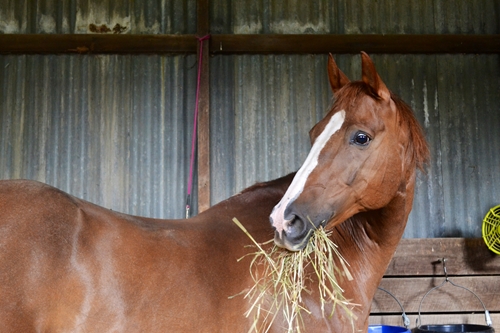
4 Ways to Support Equine Gut Health

Harness the Power: 4 Tips to Build Healthy Muscle for Your Horse
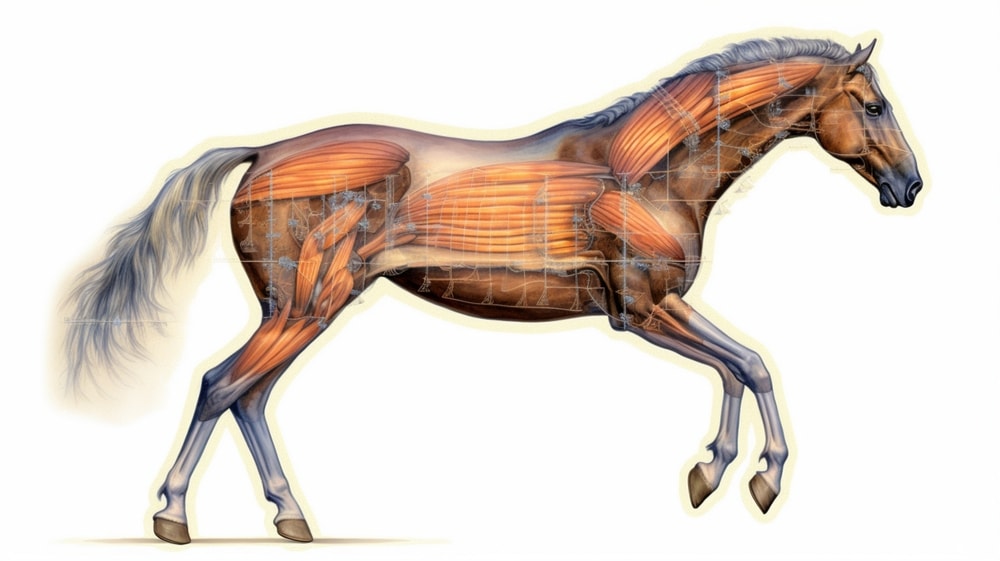
Building muscle in horses
Po box 1000 bensenville, illinois 60106, 800-762-4242, useful links.
- Customer Testimonials
- Endorser Testimonials
- History and Our Mission
- Our Guarantee
Customer Care
- Fueled by Finish Line®
- Sign Up For Our Newsletter
Product Categories
- Feed Supplements
- External Applications
Privacy Policy | Terms and Conditions

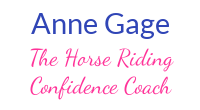
- Ride Confidently in 30 Days
- Ride Confidently in 30 Days – 1:1 Online Coaching Program
- Horse Riding Confidence Club – Monthly VIP Membership
- The Horse Riding Confidence Solution online program
- Stop Riding Scared Mini Course $27
- Winning The Mental Game Online Course $147
- Online Classes & Courses $29 – $67
- Confident Rider Confident Horse Book $19
- Host A Horse Riding Confidence Clinic
- Recommended Reading
- 7 Mindset Shifts for Horse Riding Confidence Guide
- 5 Quick Confidence Tips Cheat Sheet
- FREE Book Chapter
- FREE Articles
- FREE Confidence Call
- Horse Riding Confidence
- Horse Riding Tips
- Horse Training

The most natural thing for a horse to do is to go forward. Yet, one of the most common complaints I hear from many horse riders is "my horse won't go forward"!
So why won't your horse go forward when it's something that comes so naturally to him? Some people might blame it on a his attitude, laziness or stubbornness.
But, the most common reason is that something is getting in the horse’s way – something that makes him feel uncomfortable or disturbs his natural balance and rhythm.
Read on for the most common rider errors that block the horse's natural movement, and some tips for correcting them.
4 Common Rider Errors That Stop Your Horse From Going Forward
Error #1: rider tension and imbalance .
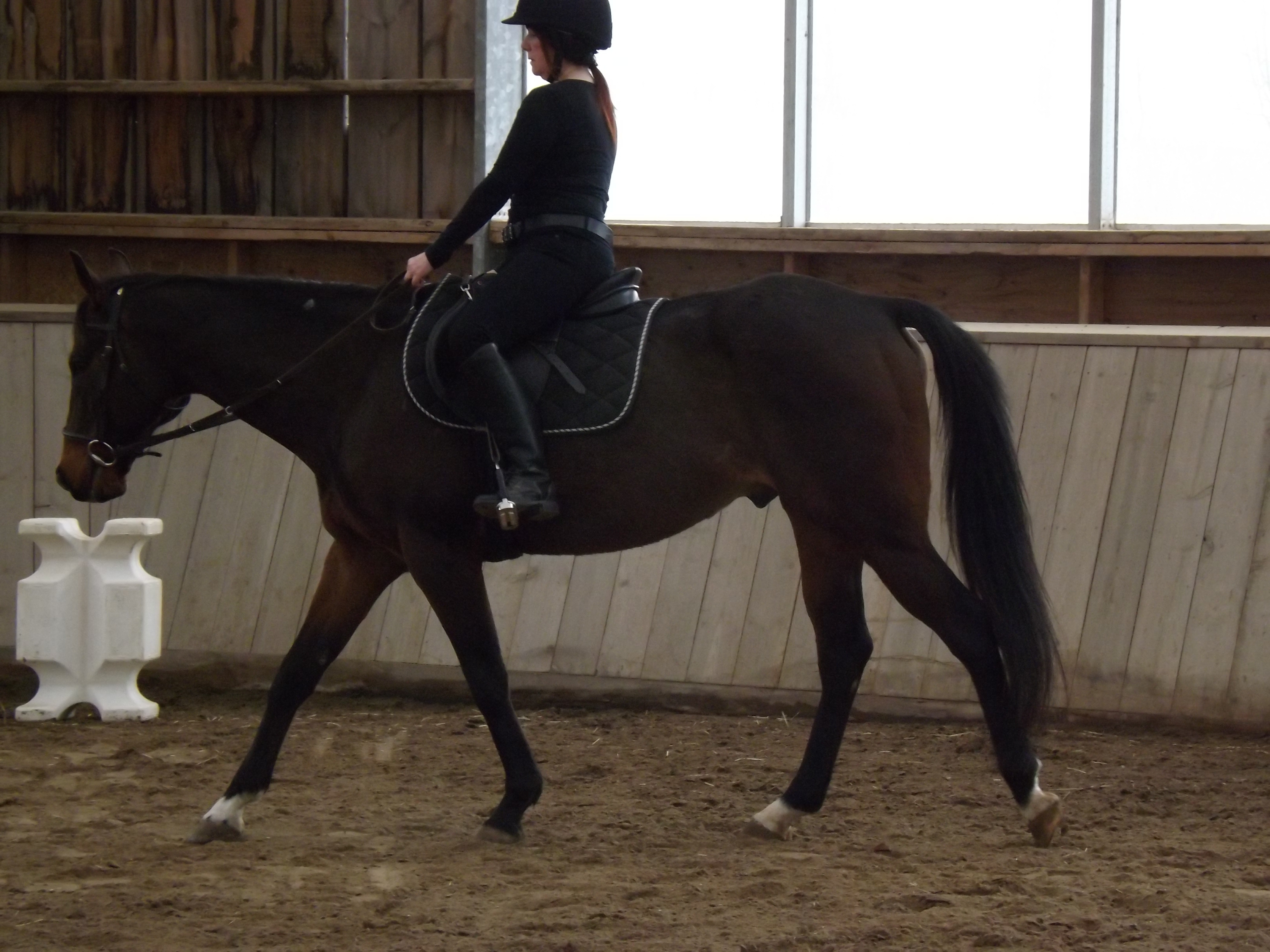
Tense arms, legs and joints create a stiff rider who interferes with her horses
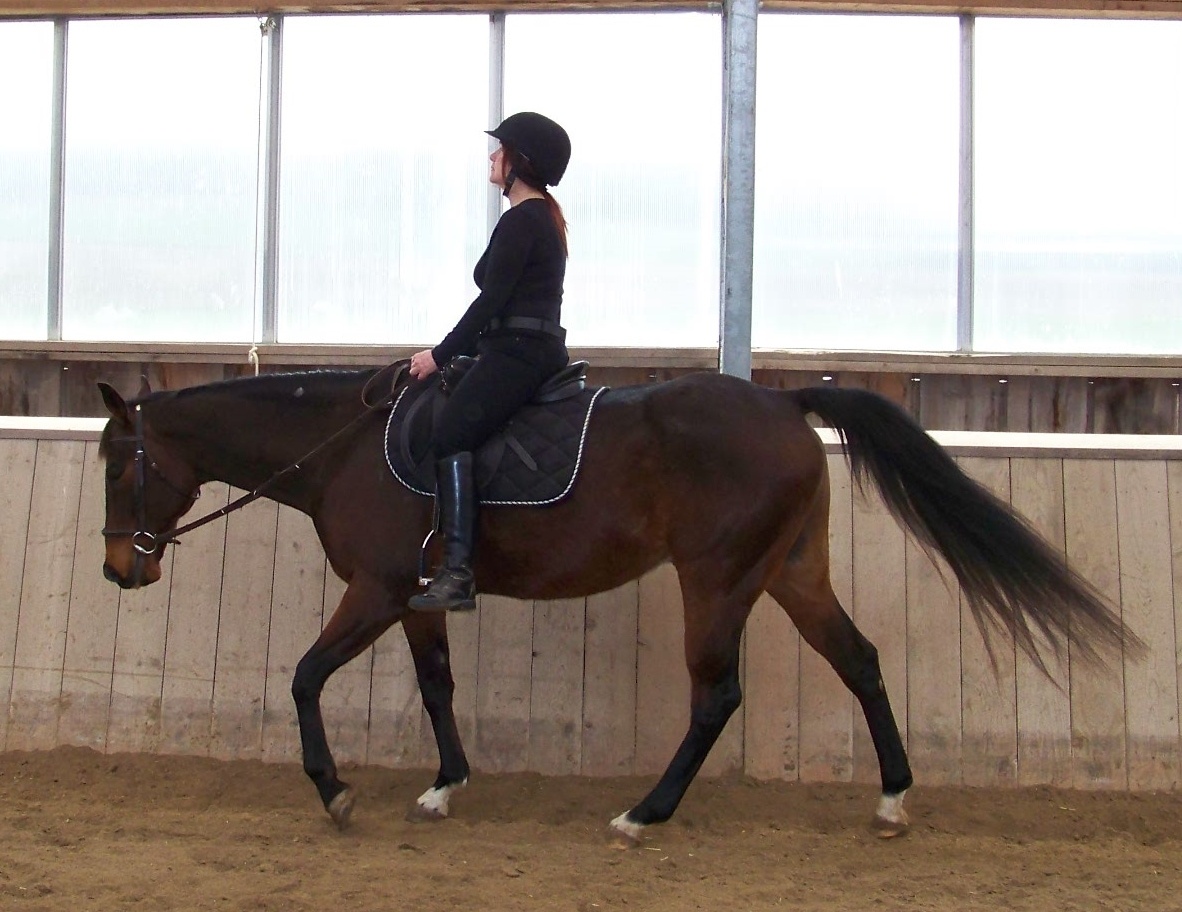
Correctly aligned and supple the rider sits balanced over her seat bones
Rider tension and imbalance is a common cause of stopping your horse from going forward willingly. Because that tension interferes with his natural rhythm and movement. And that prevents him from being able to forward comfortably.
Every horse has an unique rhythm to his movement.
When a horse is relaxed, balanced and supple, his head nods (in walk and canter, but not in trot) and his back swings.
Stiffness anywhere in your body (even in your fingers or toes) creates tension in other parts of your body ... and that blocks your horse from going forward easily and comfortably.
Soften all your joints and muscles ... from your jaw and neck right down to your toes.
Allow your thighs to lengthen so your knees drop towards the ground.
Drop your shoulders and soften your elbows. Soften your buttocks and your lower back.
Error #2: Stuck Pelvis
Many adult riders are stuck in the hips or pelvis. And that stops their seat from following the horse’s motion.
You might notice that you struggle to feel your horse's movement.
This stiffness interferes with your horse's ability to swing his back comfortably. And therefore he can't move forward easily.
So, your horse stops moving forward willingly because it just feels uncomfortable to do so. The seat that does not follow the horse's movement hurts his back.
The Fix:
To have a following seat, you need to relax your buttocks and inner thighs so that your:
- pelvis and seat bones move independently at the walk;
- pelvis rolls forwards on the up beat of the posting trot; and,
- pelvis rolls forwards on the down beat of the sitting trot and canter.
Avoid relying on your stirrups for support as this makes your legs, hips and lower back become tense.
Error #3: Crooked Rider
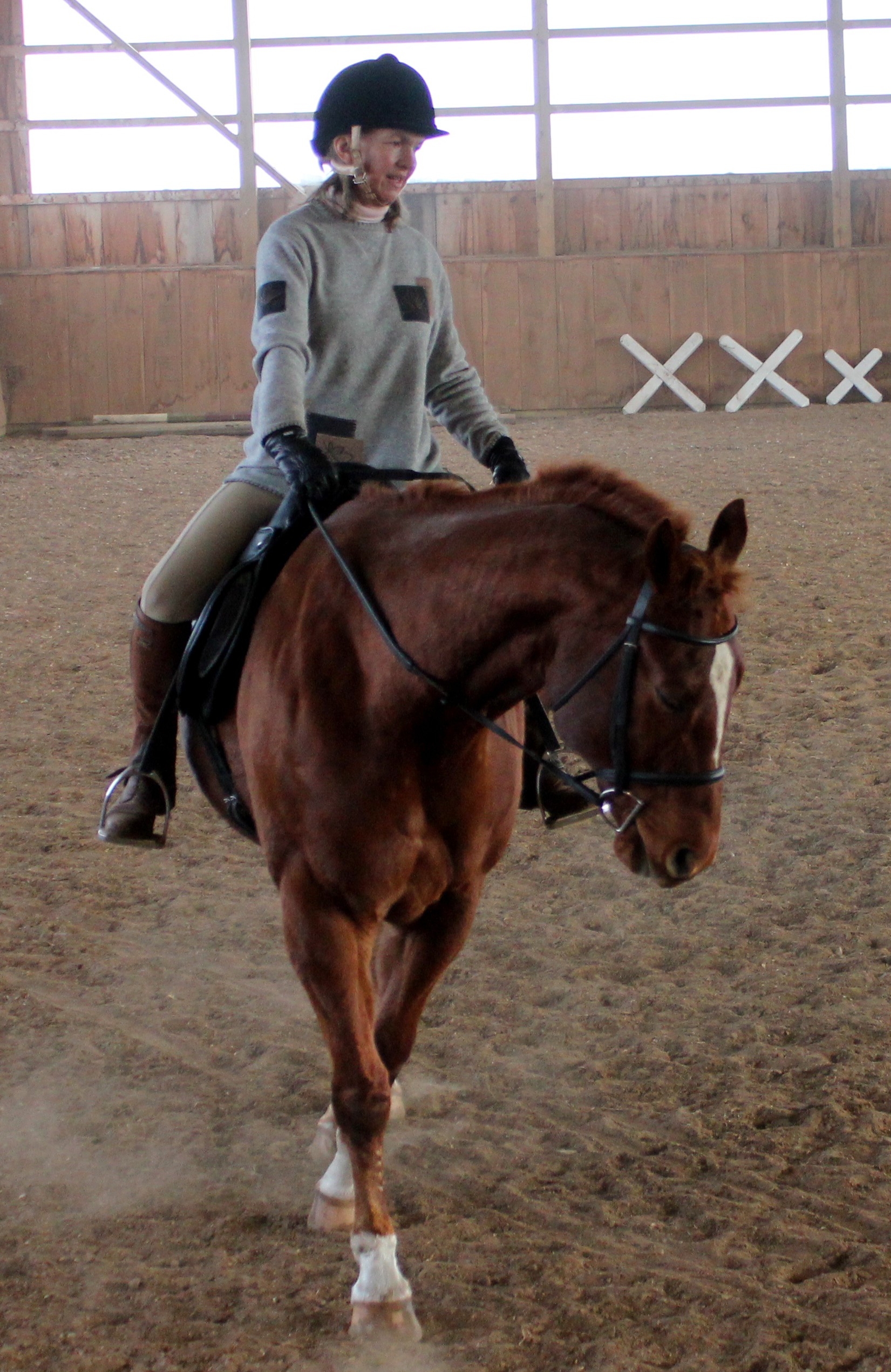
When you're crooked, you pull your horse into crookedness.
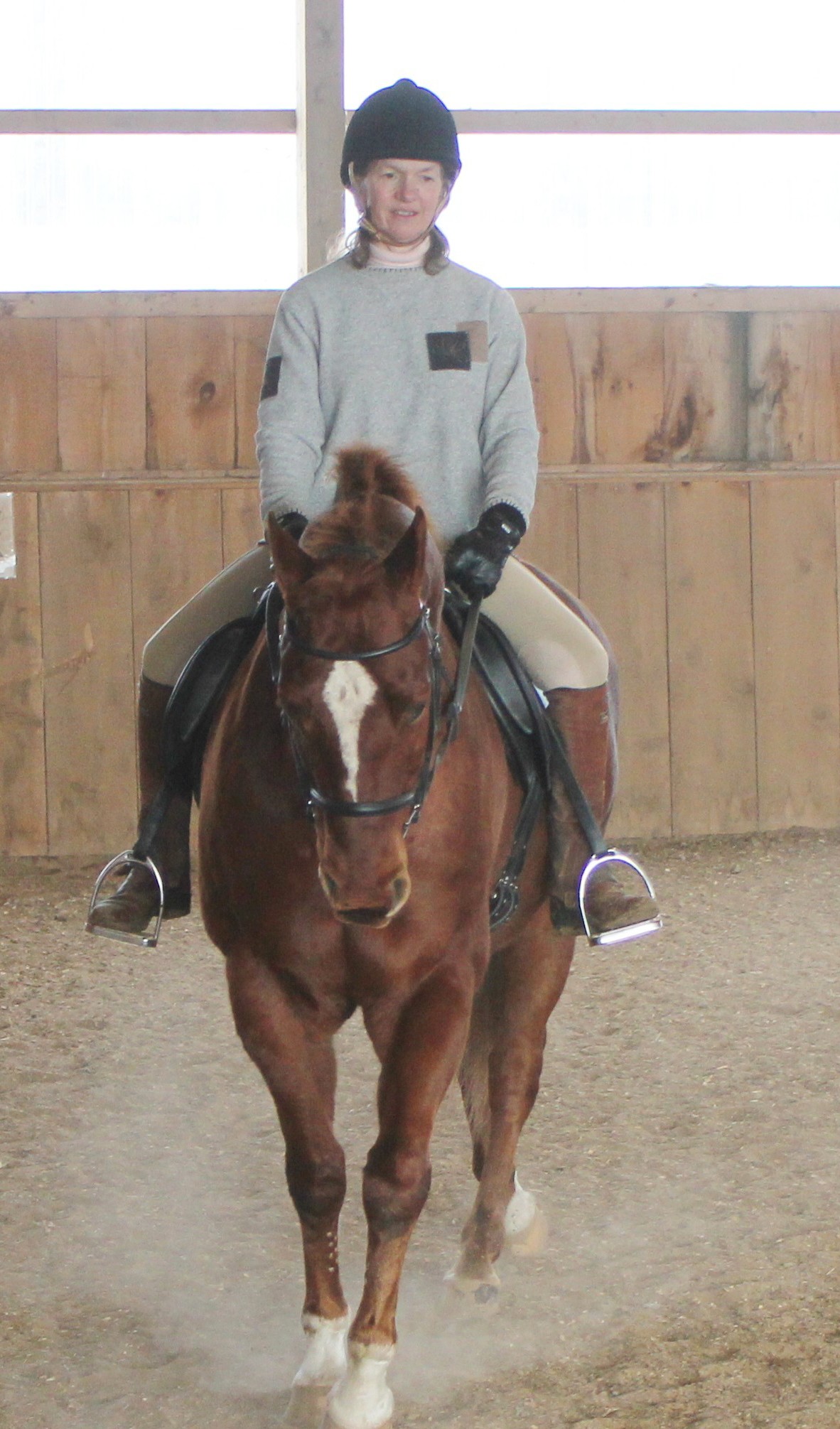
Straightness in horse and rider eliminates resistance.
Crookedness is often created by the rider sitting crooked with one hip further forward than the other, having more weight in one side than the other, or using one rein more than the other.
And the rider's crookedness makes the horse crooked.
A crooked horse is tense and imbalanced. And that stops your horse from being able to go forward easily.
In each situation, your horse feels more pressure on one side of the bit than the other. And that creates resistance in his jaw, poll and neck.
Keep your hips and shoulders square and aligned with your horse's hips and shoulders. Help your horse to be straight between your seat bones, legs and reins.
Your horse is straight when his nose is aligned with the centre of his chest, his shoulders and hips are square and he bends slightly around your inside leg.
Error #4: Pushing hard, squeezing and kicking
Pushing with your seat and squeezing or kicking with your legs all create tension in your body . And that tension creates tension and resistance in your horse. And that interferes with your horse’s ability to create impulsion - which is what he needs to go forward.
So, when you push, squeeze or kick harder to ask your horse to go forward, you're tensing up your body which prevents your horse from going forward.
Apply your aids in time with your horse’s movement . Feel your left and right seat bones and hips being moved by your horse’s hips and barrel swing. Then apply your seat and leg aids with those movements.
As one hip moves forward, push down and forward with that seat bone.
As one hip drops push gently with that calf. Your same side leg and seat bone work together on the same beat.
At the trot and the canter, apply your pushing aids on the down beat.
Use a scale of 1 to 5 for pressure. 1 is soft, passive and just in contact with your horse. 2 is a light push. 3 is a bit stronger, and so on. Move through the scale one step at a time always returning to 1 in between.
The Bottom Line: Tension, crookedness and imbalance in you affects your horse. And it's that tension, crookedness and imbalance that prevent him from being able to go forward easily.
When you become more supple and balanced, you can help your horse do the same. With the tension and discomfort removed, you will both soon be moving forward in harmony together.
FREE DOWNLOAD
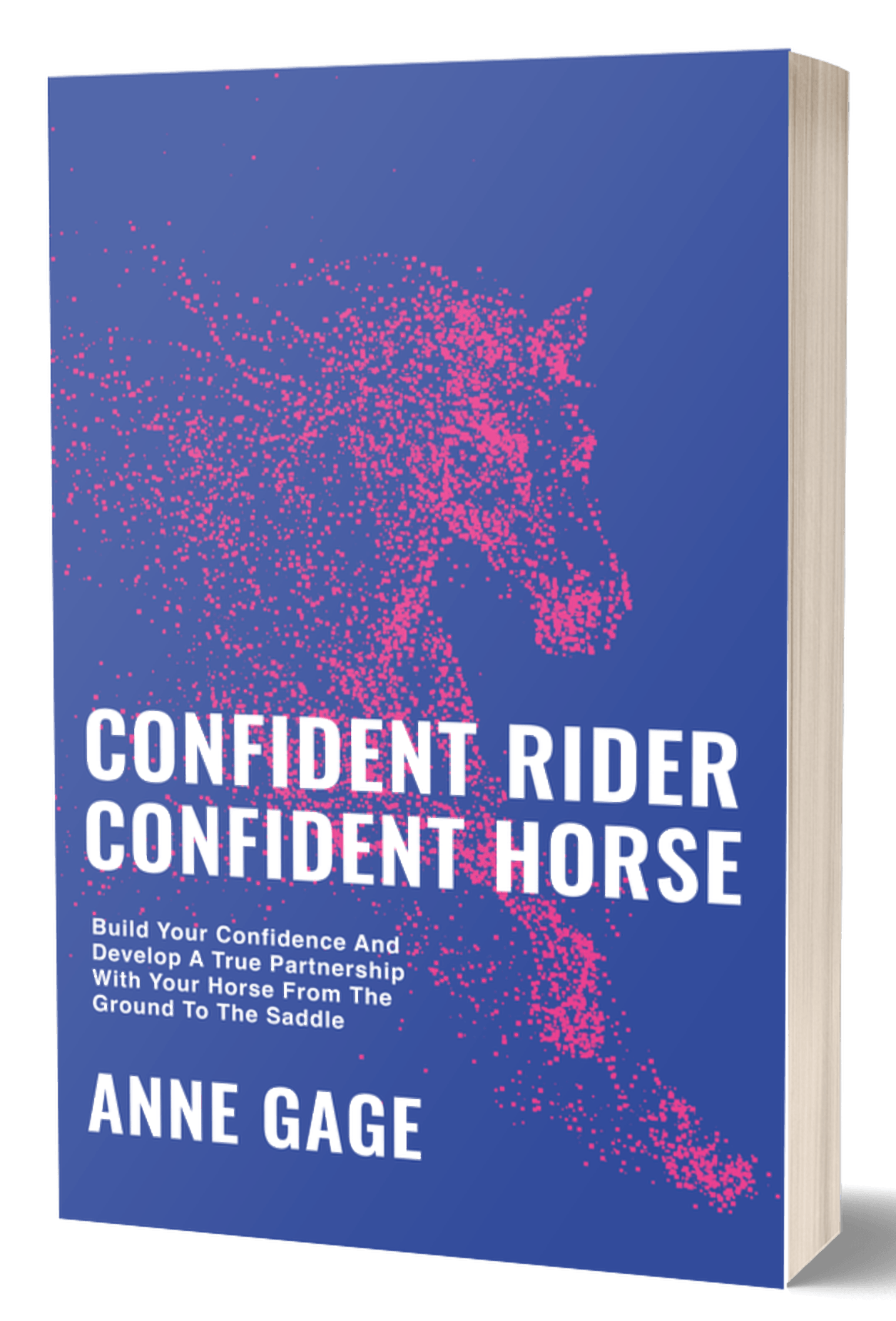
Be the rider your horse needs you to be.
"After 12 years of fear I feel that I am finally coming into my own. Thank you again for your well planned book. I wake up each morning looking forward to my morning ride, and I think my horse does too!" - Katherine M.
This free (and downloadable) chapter gives you a sample of the proven and effective confidence building techniques I used to rebuild my own confidence.
Start using them right away to feel calmer about riding your horse.
Enter your details below to get you FREE CHAPTER NOW.
*You will receive occasional emails with tips on building your confidence and partnership with your horse. You can unsubscribe at any time.

- Privacy Overview
- Cookie Policy
This website uses cookies so that we can provide you with the best user experience possible. Cookie information is stored in your browser and performs functions such as recognising you when you return to our website and helping our team to understand which sections of the website you find most interesting and useful.
More information about our Cookie Policy

MORE RESULTS

- Behavioral Problems
- Nutrition Corner
- Conditioning
- Farm and Barn
- Parasite Control
- Horse World
- EQUUS Extra
- Digital Subscription
- Subscribe to the Magazine
- Give a Gift
- Manage Subscription
- Digital Edition
Home > Behavior > Separating overly attached horse buddies
Separating overly attached horse buddies
- January 4, 2024
- ⎯ Jennifer Williams, PhD
Friends are a good thing for a horse to have.
Who wouldn’t want a partner for swatting flies head-to-tail in the field, a fellow scratcher for that itchy spot just behind the withers and a cohort in raising mealtime rackets? And from an owner’s point of view, it’s comforting to know that your horses aren’t lonely when you’re not around.

But firm friendships between stable- and herdmates can have a downside. When two horses become so attached that any form of separation leads to stress verging on panic, the virtues of companionship are outweighed by the complications it brings. Trail riding or training just one of the pair becomes difficult, if not impossible. Showing can be pointless and embarrassing when the horse in the ring screams incessantly for his partner back in the trailer. In the worst cases, a bonded pair cannot be out of sight of each other without one or both of the buddies becoming unruly and even dangerously unmanageable in their efforts to be reunited.
Separation anxiety is rooted in the lifestyle of wild horses, whose social attachments are literally a matter of life and death. But domesticated horses can form bonds—sometimes with horses they’ve just met—that exceed the depth and strength of those in nature. Breaking these obsessive friendships is essential if the two parties are to be reliable, manageable, productive horses, but making the separation can be quite a challenge. You’ll need patience, creativity and the capacity to be the “bad guy” to break up the duo, but you’ll be well rewarded when you can finally go about your daily caretaking and enjoy outings without having them sabotaged by the inseparable pair.
The Ties that Bind
Equine bonds in the natural state are strong but far from inalterable. In the wild, horses live in either harems or bachelor bands. Each harem is composed of several mature mares (often three or four, but sometimes as many as 12) and their young, protected by a mature stallion. When fillies reach maturity, they either leave on their own and move into different harems or are “stolen” by other mature stallions. When colts reach maturity and are driven out of the harem by their sires, they join bachelor bands made up of other young males and older stallions who have lost their harems.
Harems and bands offer their members companionship, access to critical resources and, most important, protection from predators. The lead stallion vigilantly watches over his harem as they graze, drink and sleep. He alerts his harem to threats, often with a loud whinny. He fights to drive other stallions away from his harem, and he herds his mares and offspring away from predators or other threats. The alpha mare often leads the harem to watering holes and grazing ground and away from other groups to prevent intermixing. Bachelor bands are not as well organized, but they still offer member stallions protection from predators as certain members act as sentinels while the others graze or rest. Individuals separated from their harems or bands are easy targets for predators.
Wild horses know the importance of sticking with the group at all costs, and even after thousands of years under human management, domesticated horses have retained this valuable lesson. However, the bonds between individual horses within free-roaming bands and harems aren’t necessarily tight, particularly when judged by human social values. Daughters and sons leave their mothers every year with nary a whinny or backward glance by either party. If a bachelor stallion steals a mare from a harem, she follows willingly, and her former harem mates don’t pine for her. Bachelor bands are particularly unstable, with members constantly coming and going with little stress or strife. To the wild horse, companionship is crucial to survival, but the specific companions are irrelevant.
Why, then, do some domestic horses form implacably tight bonds with select associates? The personalities of the horses involved, their social setup and the level of stress in their lives all come into play, but there is no standard profile of the buddy-bound horse. The most common separation-anxiety situation I see occurs between two horses who have had only each other as company for many, many years. That said, I’ve seen lifelong stablemates who could care less when separated from each other. Some horses aren’t particular about their attachments and bond with any horses stabled next to them in a matter of hours. In general, highly strung, emotionally needy horses are more prone to forming unhealthy attachments, but very secure horses can form immediate and tight bonds when they’re in sufficiently stressful situations.
Two domestic horses who spend the majority of their days in close proximity to each other are quite likely to bond deeply. My own two horses, for example, were never particularly attached to each other until I moved across the country with them. After two 14-hour trailer rides and a new home, they suddenly can’t live apart. Turned-out horses may form a single large herd or break down into small, distinct groups. A horse can become agitated when asked to leave his group rather than any particular individual in it. Horses who are kept in small, adjacent paddocks or confined in stalls form bonds to the horses next to or across the aisle from them.
The signs of separation anxiety are unmistakable. Separated buddies scream for each other, pace pasture fences or spin in circles in their stalls. Someone who doesn’t know the social history may even think the anxious horse is colicking. Turned-out horses with attachment problems may be hard to catch and reluctant to leave their herds or pals once they are collared. Sometimes only one of the bonded pair gets worked up, but often both parties become agitated when they lose sight of each other. The most telling sign of unhealthy attachments is how the horses act when reunited: If they immediately settle down, you know the separation was the cause.
Click here to learn how to spot the signs of depression in horses.
Before the Break
One approach to managing separation anxiety is to leave the buddy-bound horses together forever. This strategy works only if you never want to ride or compete just one of the two and if you can be sure you’ll never have to face an emergency situation when only one horse must be transported elsewhere.
A far more practical solution is to retrain the two for some emotional independence. The widespread notion that deeply bonded pairs of horses cannot be separated without risking severe emotional trauma is just not true. Breaking the bond is hard and you’ll feel like an ogre doing it, but the horses won’t be harmed. I’ve yet to meet two horses who couldn’t be separated and function as happy individuals.
Separations usually have to be abrupt and unwavering to be effective. The soft and slow approach of separating the horses for increasing amounts of time each day simply prolongs the turmoil and perpetuates the anxiety. But before making a swift split, you need to analyze the cause of the problem and make appropriate preparation for the ultimate separation.
If the horses appear to have bonded because of stress, deal with the source of the stress first. When their lives are in turmoil, they need each other. For instance, when two horses who have bonded during an abusive situation come into Lone Star Equine Rescue, the organization I run, we wait until they are healthy and more trusting of people before splitting them up. In a situation where the unfamiliarity of travel and competition turns your occasional show horses into inseparable screamers, stress reduction might simply be more frequent outings, so the show experience loses its fearfulness.
Once you’ve eliminated underlying stressors that contribute to unhealthy bonding, evaluate the horses’ ground manners. Bonded pairs that include young, green or otherwise unruly individuals need some basic education to teach the horses to focus on and obey you above all other distractions. During these sessions, I take one horse at a time to an area where he can still see and hear the other and work on leading, backing and responding to my commands. I have them perform more complicated ground exercises, such as walking through pole mazes, to command their attention. If you’re into round-pen training, you might try a bit of that.
Lots of praise and possibly food rewards go a long way to making the horse realize that I’m a worthy companion. Be patient and systematic; establishing ground manners may take 10 or more sessions.
Making the Split
Once the horse focuses on me and is safe to handle while on his own but still in the vicinity of his pal, you can make the split. The best option is to remove one horse from the property for at least two weeks. The back-and-forth whinnying of two horses within earshot of each other can drive everyone nuts. The next best solution is to house the horses on opposite ends of your property, where they aren’t going to see or be in contact with each other. Put another horse nearby each of the separated pair for companionship and distraction, and make the break at dinnertime when they will be focused on eating.
The horses are quite likely to scream for each other, pace and generally carry on, which will make you feel awful. Resist the urge to put the pair back together unless one is at risk of injuring himself in his frenzy. Two hours seems like forever when you’re watching a horse pining for his buddy, but in confirmed cases be prepared for the anguish to go on for two or three days. Cut out the grain meals, and keep hay in front of separated horses at all times as both a distraction and an antidote to stress-induced digestive troubles. A horse who stops his racket to eat and drink has his priorities straight and will most likely become fully adjusted to the change within a week.
If a separated horse seems to be at risk of becoming ill because he’s not eating or drinking, he’s losing weight or he’s fretting to the point of exhaustion, ask your veterinarian about sedation. Calming drugs can cause unwanted physiological effects, and your veterinarian is the one to decide if and how such medications should be used.
Maintaining the Change
Eventually, all separated horses settle down. At that point, turn your attentions to preventing new unhealthy reattachments. If possible, change stabled horses’ neighbors frequently, which might mean playing musical stalls every three or four days. For field-kept horses, frequent changes in herd members can be very disruptive to the overall hierarchy, so put newly separated turned-out horses in small paddocks with one or two rotating companions to make new mini-herds every few days.
Once the separated pair appears to have gotten over each other, you can try putting them back in same area, but be very, very watchful for signs that they are reattaching. When you intervene quickly to nip a returning obsession in the bud, separation won’t cause the same extended turmoil as the original division did. If your herd is small and there’s no way to keep the two apart for the long term, make it a point to ride the bonded pair separately every day and to go off the property with them individually as often as possible. For horses who get particularly attached at competitions, arrange to work the individuals on the show grounds in early warm-up sessions or schooling during non-show days. Such excursions are low stress for you and great experience for a horse who needs to become comfortable away from home and his or her bosom companion.
Of all the behavior problems of horses, separation anxiety can be one of the most troubling to deal with. On one hand, the solution seems simple: Just leave the horses together forever so everyone can enjoy the peace. On the other hand, failing to confront the obsession puts you in a really tough situation when one horse is injured, sold or otherwise must be separated from the other. The solution to obsessive friendships usually isn’t difficult, but it does demand some creativity in devising a safe way to separate the pair and thick enough skin to follow through even during the worst of the emotional turmoil. Learning to let go is as important a lesson for domesticated horses as it is for their brothers and sisters in the wild.
Case Study: The Only Two Horses in the World
Bastet and Lear were a pair of healthy, well-tended part-Arabians who came to Lone Star Equine Rescue because their owners could no longer care for them. Bastet was nearly 25 years old and Lear was her 19-year-old son. When the volunteers arrived, the two horses were grazing side by side in their pasture and were easily caught and led to the trailer. Bastet walked willingly up the ramp, but the moment she was out of view, Lear began dancing at the end of his lead and neighing nervously. When his dam called, he became even more agitated and charged into the trailer.
At their new home, the two were put in adjoining stalls, with a solid wall between them. Lear paced and fretted, unwilling to eat or drink, revealing an unhealthy degree of attachment to his dam. Bastet called back to him occasionally but didn’t seem as upset. The next day, when a trainer took Bastet from her stall, Lear whinnied so loudly that other boarders at the barn rushed to his stall, concerned that he was being hurt.
In reviewing the case, we realized that the pair had lived together with only each other for company for 19 years. As far as Lear knew, his dam was the only other horse in the world, and without direct access to her, his whole life was in turmoil. Adopting out horses is difficult, and finding one home to take a bonded pair is nearly impossible, so we decided that to ensure Lear’s future, he had to be “weaned” at the age of 19.
The mother and son remained in the adjoining stalls, and for the first few days Lear paced the dividing wall and frequently nickered to her. Gradually, he stopped pacing and settled down. Once he accepted that separation, Bastet was moved to an outside pen next to another horse who could provide her with companionship, and Lear was left in his stall, also with a new companion. Bastet occasionally whinnied for Lear, but Lear called nearly constantly for Bastet for the first week of their separation. We found ourselves repeatedly explaining to other boarders that what we were doing wasn’t cruel and unusual.
After a week, Lear quieted and began to show an interest in the horse next to him. After that, the gelding was moved to various stalls and paddocks so that he always had companionship but with different horses. About a month later, Bastet was adopted, and a month after that, Lear moved on to another home. Both horses are doing fine physically and emotionally in their new homes with new horses for companionship. This case, in particular, taught me that even the most deeply rooted cases of separation anxiety can be overcome.
Case Study: Bonded for the Moment
Jawhari was a young Arabian gelding who had just begun his show career. Scooter was an older Quarter Horse who was used to traveling to shows. The two horses were kept on the same property but lived in different barns and were never near each other. I’d call them acquaintances but not friends.
When Scooter accompanied Jawhari to his first show, however, the stress of the situation drove the younger horse to decide that Scooter was his soul mate. While in the showring, Jawhari repeatedly called for Scooter, who ignored him. Needless to say, Jawhari was not the star of that show.
Once the pair returned home, they went to their separate barns, and Jawhari no longer called to or watched for Scooter. Their attachment was associated only with the stress of the show. Jawhari’s owner took him to another show the following week with a different horse and continued to regularly take the gelding places with new companions. Eventually, as traveling became commonplace, Jawhari no longer bonded with his trailer companions and is today a successful show horse.
Case Study: Sorrowful Partings?
We’ve all heard stories of horses who have grieved inconsolably for months after the death of an equine friend. I’ve even heard of horses who “died of a broken heart” after the passing of a pal. As touching as these stories are, I view them as products of our human interpretation of companionship and death. The fact that we are heartbroken over the passing of a horse may lead us to see his remaining companions in the same emotional state to help us share the burden of the loss. A horse who is suddenly without a long-term companion may miss that horse and even become anxious and depressed in his absence, but horses have no concept of death. The “grieving” that we see is simple separation anxiety and, when treated as such, will resolve itself as if the deceased horse had simply been moved to another barn.
This article originally appeared in EQUUS magazine.
Don’t miss out! With the free weekly EQUUS newsletter, you’ll get the latest horse health information delivered right to your in basket! If you’re not already receiving the EQUUS newsletter, click here to sign up. It’s *free*!
SHARE THIS STORY
Related posts.

" * " indicates required fields
Additional Offers

Copyright © 2023 Equine Network LLC
MORE RESULTS

- Andrea Fappani Tips
- Ground Work
- Pattern Perfect
- Private Lesson
- Ranch Events
- Reining/Cow Horse
- Showmanship
- Western Horse Tack
- Trail Class
- Western Pleasure
- Horseback Trail Riding Training
- Where-to-Ride Guide
- Horseback Trail Riding Safety
- Conformation Clinic
- Horse Behavior
- Horse Deworming
- Horse First-Aid
- Horse Grooming
- Horse Hoof Care
- Horse Nutrition
- Horse Trailering
- Horse Vaccines
- Horse Shopping
- Rider Fitness
- Stable Management
- Western Riding Apparel
- Horse Humor
- Horses We’d Like to Own
- My Collection
- You Said It
- Your Stories
- Ranch Sorting
- EDCC Health Watch
- Mars Hackamore Classic
- Ranch Horse Triple Crown Challenge
- The Thinking Rider
- The Rider’s Mindset
- The Safe Start
- OnStaff at Horse&Rider
- Subscribe to the Magazine
- Give a Gift
- Manage Subscription
- Digital Edition
Learn to nail your lope transitions with this demonstration from world champion trainer Carol Metcalf.
- March 17, 2015
- ⎯ Carol Metcalf
If your reasonably well-broke horse won’t pick up the correct lead when you ask him to (and assuming there’s no physical reason for his reluctance), then you’re probably not cueing him properly. My guess is you’re making the common mistake of trying to “tip and drag” your horse onto the correct lead. It generally doesn’t work, and when it does happen to work, it’s ugly.
[READ: Carol Metcalf – Reining Queen ]
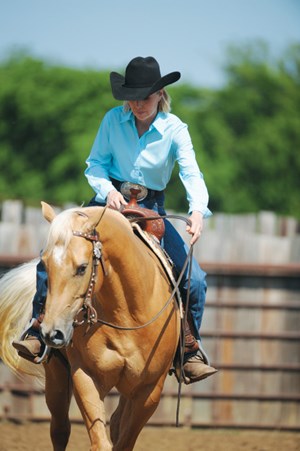
I’m going to explain how to position yourself and your horse properly for a balanced, beautiful strike-off at the lope—on the correct lead. With diagrams, I’ll show you the right and wrong ways to set your horse up for the lope transition. With photos, I’ll demonstrate the mistakes you’re probably making, then show you the correct way.
To make use of what I’ll teach you, you need to have certain basics already established with your horse. He needs to flex willingly at the poll, straight back or laterally, when you ask him with the reins. He also needs to move his hindquarters over in response to pressure from your leg. These skills will enable you to properly position his body so a correct lead departure is practically guaranteed.
As you practice what I’m about to teach you, outfit your horse in a snaffle bit for best communication, and work on level ground with good footing for safety’s sake.
[READ: Fix Lead Change Anticipation ]
MIND THE BEND
Look at the diagram labeled “Correct Arc.” The horse’s body is arced so his head and his hips are tipped slightly to the inside of the circle. In this position, his outside hind leg will naturally step off into the first beat of the three-beat lope. Next, his other hind leg and the diagonal front leg will come down simultaneously for the second beat. Then, the remaining front leg—the inside leg—will come down for the third beat. Voilá—you’re on the correct lead!
Now, look at the diagram labeled “Incorrect Arc.” This horse is improperly set to lope off, because he’s counter-bent to the circle. I’ll explain how this happens in a moment. Right now, just know that this position makes it hard for your horse to pick up the correct lead in two ways: (1) It causes him to lean on his inside shoulder, which keeps him from lifting that shoulder to free his inside front leg and balance over his hind end; and (2) With his hips to the outside like this, his outside hind leg isn’t positioned to take that first step of the lope stride.
[READ: Straightness for Lead Changes ]
SET UP FOR SUCCESS
Now, let’s talk about how to get that correctly-arced body position so your horse can easily and smoothly pick up the correct lead.
The right way. After warming your horse up, put him on a large circle at a walk. As you look in the direction you want to go, lift your inside rein several inches directly up. This tips his head to the inside of the circle and “lifts” his inside shoulder, encouraging him to balance himself over his hind end. (I find lifting my hand about six inches adequate to achieve these results, though you may need to experiment with how much is most effective for your horse.) Meanwhile, keep enough pressure on your outside rein to keep him from drifting into the circle or tipping his head too far to the inside.
At the same time, apply pressure with your outside leg several inches behind the cinch to push your horse’s hind end slightly to the inside of the circle. Keep your inside leg at the cinch to encourage the correct bend. If you’ve accomplished all this, your horse should be bent a bit to the inside of the arc of the circle, just like the horse in the “correct” diagram.
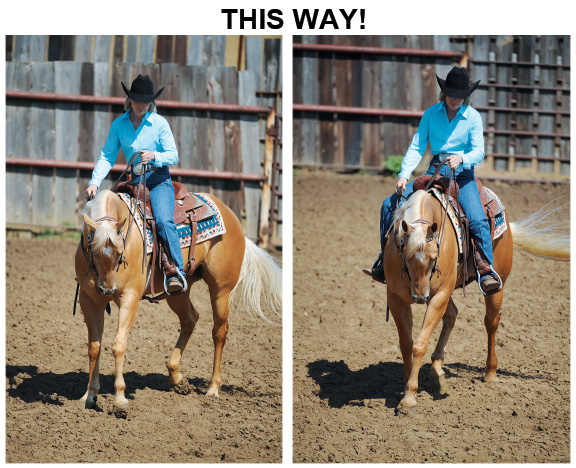
LEFT: I’m lifting my inside rein to pick up my mare’s inside shoulder and tip her nose to the inside of the circle. My outside rein is keeping her from bending too far or getting crooked. My outside leg is pushing her hind end in—and look how her outside hind leg is set to make that first step of the lope. All I need to do now is “kiss.”
RIGHT: And here it is—a soft, smooth transition to a beautiful lope, on the correct lead, with the mare flexed at the poll and properly bent on the circle through her body. Remember to always look up in the direction you wish to go; I’m concentrating a bit too much on my demonstration and should be lifting my chin and my eyes a bit.
The wrong way. What you don’t want to do is what riders often do: “throw” your horse into the lope by leaning your body and carrying your hands to the inside of the circle. When you do this, your outside rein winds up tightening too much across your horse’s neck, so you actually tip his head to the outside—the opposite of what you want. Also, you’re enabling your horse to dive onto his inside shoulder, rather than lifting his shoulders, as you need him to.
Plus, your own tipped position in the saddle means you’re essentially putting your inside leg on your horse and taking your outside leg off—again, the opposite of what you want. As a result, his hind end cants to the outside, making it harder for his outside hind leg to get that first lope step.
All told, positioned like this, it’s actually easier for your horse to pick up the wrong lead than to get the right one.
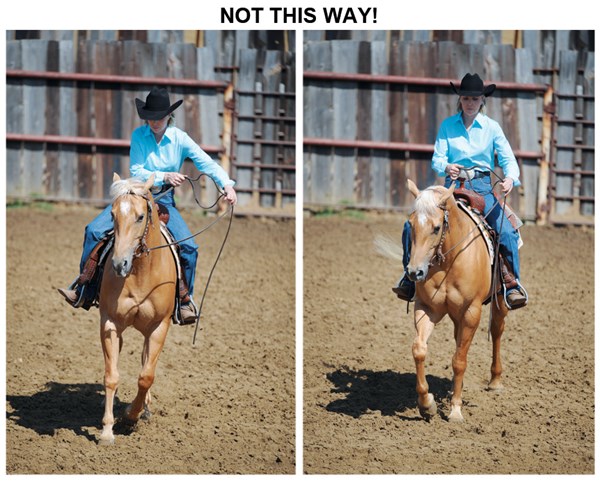
LEFT: To demonstrate what not to do, I’m leaning and carrying my hands to the inside, trying to “throw” my mare onto the left lead. I’ve actually tipped her head to the outside of the circle, and my outside leg is off her side—both exactly wrong for cueing the lope.
RIGHT:And here’s the result: My mare, still bent to the outside, is bracing against my hand and loping on the wrong lead (her outside foreleg is about to come down in the third beat of the lope). She’s not happy with me, either—note her ears and the expression on her face.
[READ: Lead Change Precision ]
As you practice, be sure to work equally in both directions. (If need be, give a bit more emphasis to your horse’s weaker lead until he’s equally fluid with both.) As your horse gets better at it, practice making your cueing more subtle and smoother over time.

" * " indicates required fields
Additional Offers
Horse&Rider provides all you need for today’s Western horse life. Learn from top professional trainers, clinicians, and horsekeeping experts. Experience Western life. Travel to Western destinations and scenic trails. Horse&Rider is your resource to live today’s Western horse life.


IMAGES
VIDEO
COMMENTS
Bring a mobile charger for your cell phone. When traveling alone with your horse, a cell phone is more than a matter of convenience; it can mean the difference between a quick response to an emergency or being stuck on your own for hours. Before going anywhere make certain that your cell phone battery has plenty of charge.
Dictate the path. Be the driver, not a passenger. If your horse would prefer to avoid a puddle, a shadow, or an unusual object encountered in your arena or work area, make him walk through the perceived obstacle, and by the scary object. His job is to go where you tell him. Be similarly diligent about arena maneuvers.
3) Don't always feed your horse in the same place. Watch any group of horses for a while and you'll notice that they will all move around and play together. While playing obviously helps horses to bond it also has a surprising benefit that you might not have considered. Just like us, horses that don't move much are likely to gain weight ...
Show your horse that going down the trail is the better option. Ask him to walk off the direction you want down the trail. If he chooses to stop or turn around that's fine, let him make that choice. Then make that choice hard, trot some circles for a few moments then point him back to the trail and slow him to a walk.
Increase the time span - gradually build up the time the horse is left. Grazing arrangements - graze a young horse beside another so they can communicate over the fence, gradually separate the grazing a little more so the horses are out of sight of one another. Hacking out alone - hacking out in company is great for young horses as when ...
5. Hit the Road. Arrange to meet other riders for a trail ride or trailer to a local arena. A change of scenery is nice and gives your horse a chance to socialize. In my experience, horses greatly benefit from being in the presence of other (calm) horses, even if they aren't making physical contact. This can be a welcome change for the rider ...
When traveling alone with your horse, a cell phone is more than a matter of convenience; it can mean the difference between a quick response to an emergency or being stuck on your own for hours. ... Given that you won't have a friend to help, be careful not to overextend yourself. If, for example, you will be competing at a horse show, think ...
Your first solo trail ride should be extremely short, preferably between 5 and 10 minutes. If your horse is very nervous, but has done a good job for only 2 minutes, however, it means it's also time to go home. This will result in your horse wanting to go trail riding, as it's such a good experience every time.
11 travel tips and necessities when traveling with horses. Traveling with horses requires prepping in advance to ensure the safety and well-being of your horses. Here's a list of essential items you'll need, as well as tips and considerations for a long-distance journey with your horse. 1. Use the right horse trailer.
Let the light in. When you start to think about walking your horse onto the vehicle, try to make the inside of it as light as possible by opening any doors or windows. Your horse's eyes take much longer to adjust to changes in light levels than yours, so whereas it might take a moment or two for your eyes to adjust from walking from light to ...
The 5 most common signs of loneliness in horses are 1) pacing/restlessness 2) loss of appetite/weight 3) calling or whinnying 4)cribbing and 5)excess kicking. Sweating or lack of normal reactions can also be indicators. To ease or treat loneliness in a horse, consider adding a smaller animal for company, like a goose or cat, and put mirrors up ...
Avoid Negative Reinforcement - Don't train through negative reinforcement, give the horse the options and make him accountable for his own behaviour. Negative reinforcement may work for a while but it won't last. Don't Give Up - Try and stick with it no matter how long it takes. Change type of transport - Some horses only refuse to ...
1,116. Visit site. Mine will travel fully tacked up to go out on a hack on his own but will not go to a show on his own! I have borrowed an outgrown pony from a friend who comes to shows (put first in box) and it works well. He will walk away from the travelling companion without a care in the world.
If you're ready to travel with your horse but you're not quite sure where to start, here are 20 tips for how to travel with your horse. Choose the Right Travel Trailer. Inspect Your Travel Trailer and Vehicle. Ensure Your Horse Can Safely Enter and Exit a Trailer. Do a Test Drive Before Extended Travel.
Here's what to do. LEFT: After you've finished longeing, remount and ask your horse to flex his neck and make a small circle at the walk. RIGHT: Then flex his neck and circle in the opposite direction. This verifies that your horse is relaxed and dialed in to you. Don't pull on both reins.
To keep your horse happy and healthy from start to finish, take into account these tips for traveling with your horse: 1. Practice loading your horses prior to the departure date so they get used to the entering, exiting process. 2. Give your horses a break about every three hours.
2. Get a friend to help with this arena exercise. Each of you will groom, tack and mount up a horse. 3. Walk the horses side by side, right down the middle of the arena. 4. On signal, the rider on the right will make a small 10' circle to the right at the same moment the rider on the left makes a small left circle. 5.
Steps you could break the training process down into might be: Catching the horse you want to take away, putting their headcollar on and then removing it again and walking away. Catching your horse, walking them across the paddock a short distance and letting them go again. Walking your horse to the gate and letting them go again.
A crooked horse is tense and imbalanced. And that stops your horse from being able to go forward easily. In each situation, your horse feels more pressure on one side of the bit than the other. And that creates resistance in his jaw, poll and neck. The Fix: Keep your hips and shoulders square and aligned with your horse's hips and shoulders.
Breaking the bond is hard and you'll feel like an ogre doing it, but the horses won't be harmed. I've yet to meet two horses who couldn't be separated and function as happy individuals. ... Scooter was an older Quarter Horse who was used to traveling to shows. The two horses were kept on the same property but lived in different barns ...
At the same time, apply pressure with your outside leg several inches behind the cinch to push your horse's hind end slightly to the inside of the circle. Keep your inside leg at the cinch to encourage the correct bend. If you've accomplished all this, your horse should be bent a bit to the inside of the arc of the circle, just like the ...
The 20-year-old gunman who tried to assassinate former President Donald J. Trump at a rally in Pennsylvania appears to have acted alone, F.B.I. officials said on Sunday, but investigators remain ...
But it was far from the country's worst travel day of the year: Bad weather forced U.S. airlines to scrap more than 3,100 flights on Jan. 15. ... you're not alone. The problem, cybersecurity ...